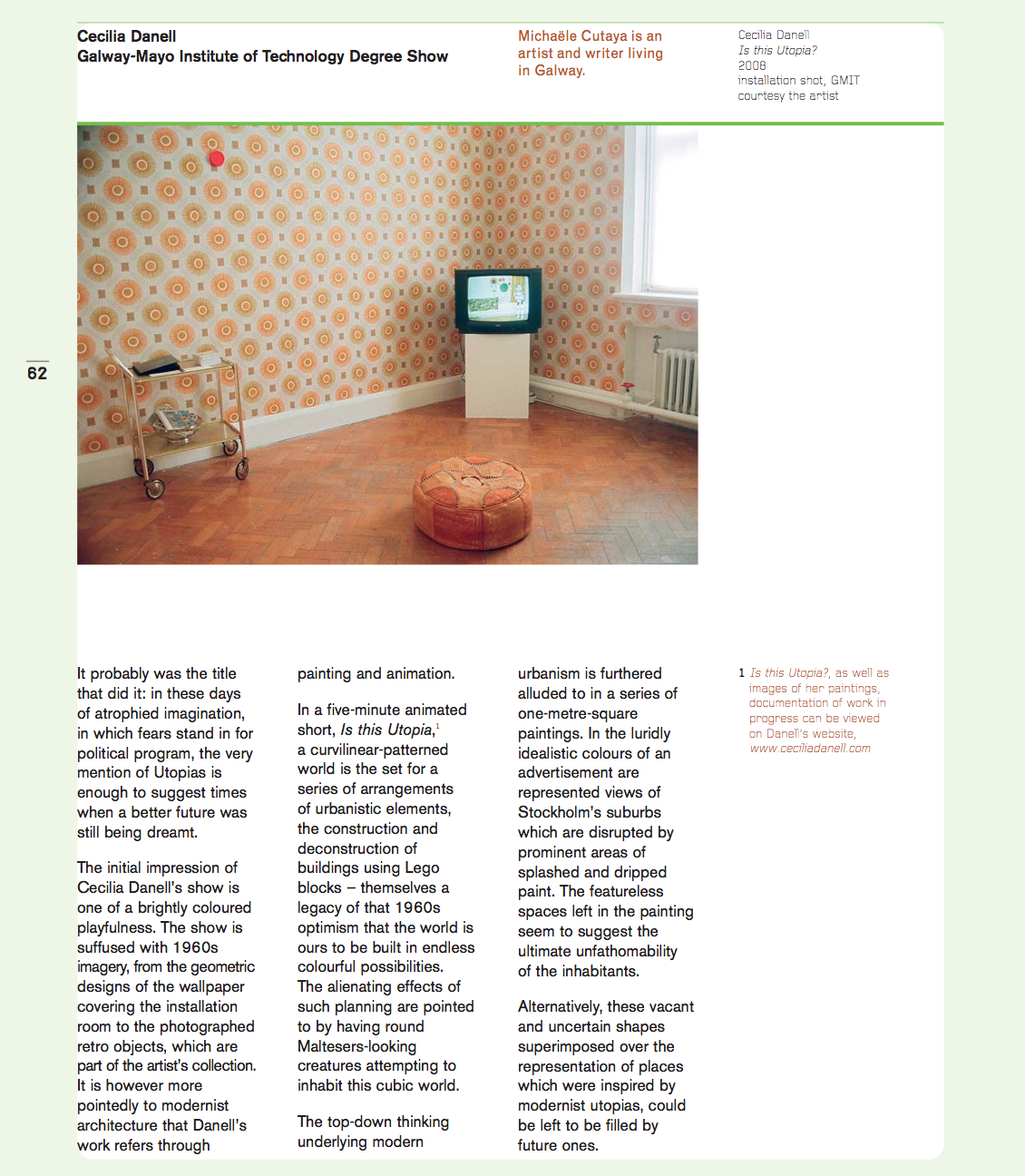The Visual Artist’s News Sheet,
January – February 2024
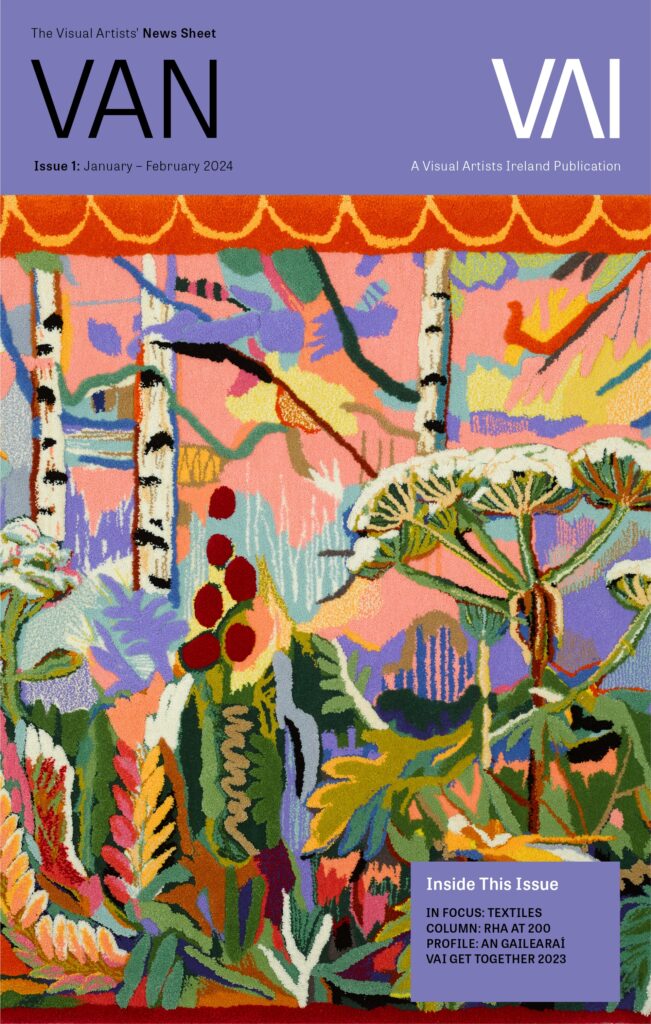
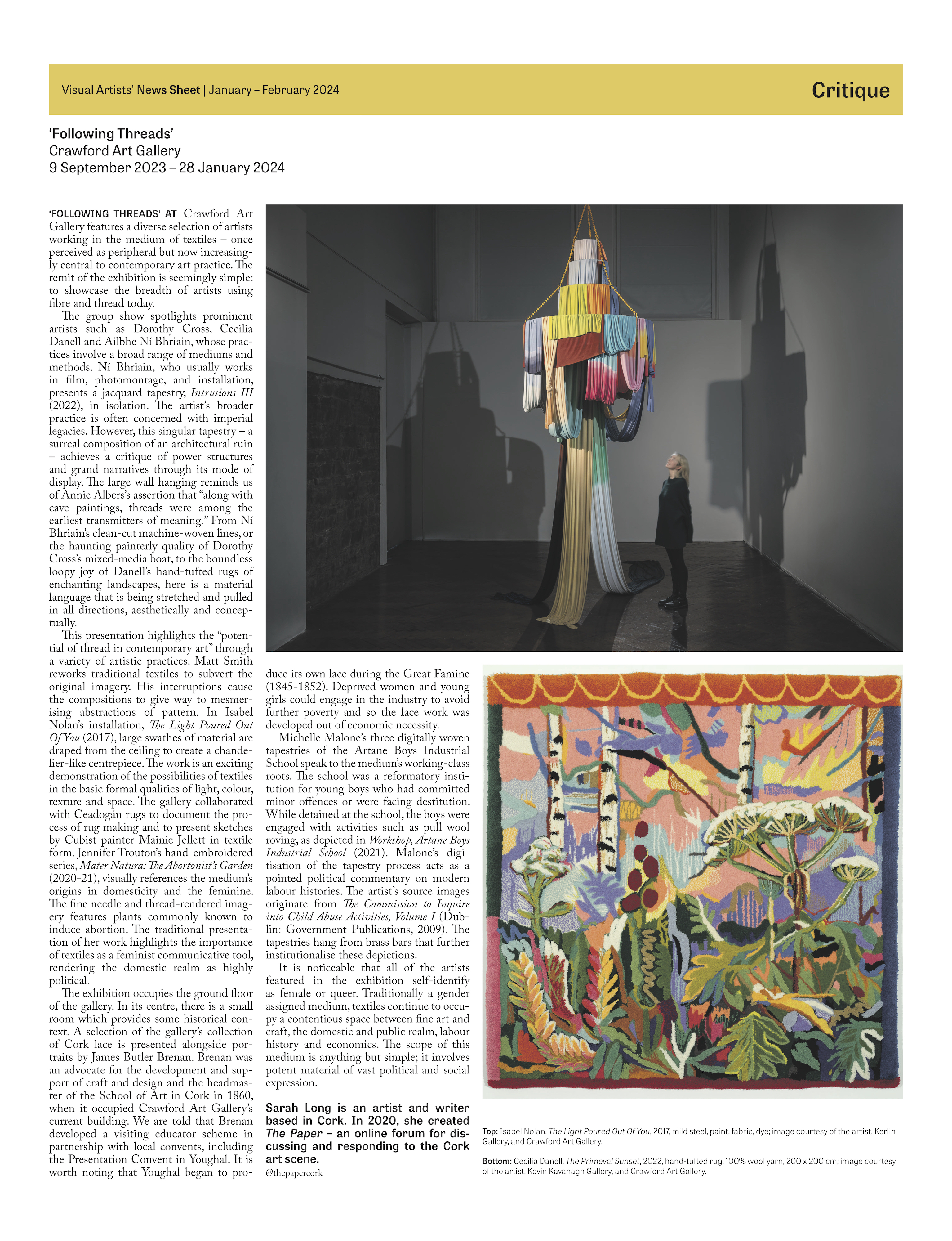
Irish Arts Review, Winter 2023
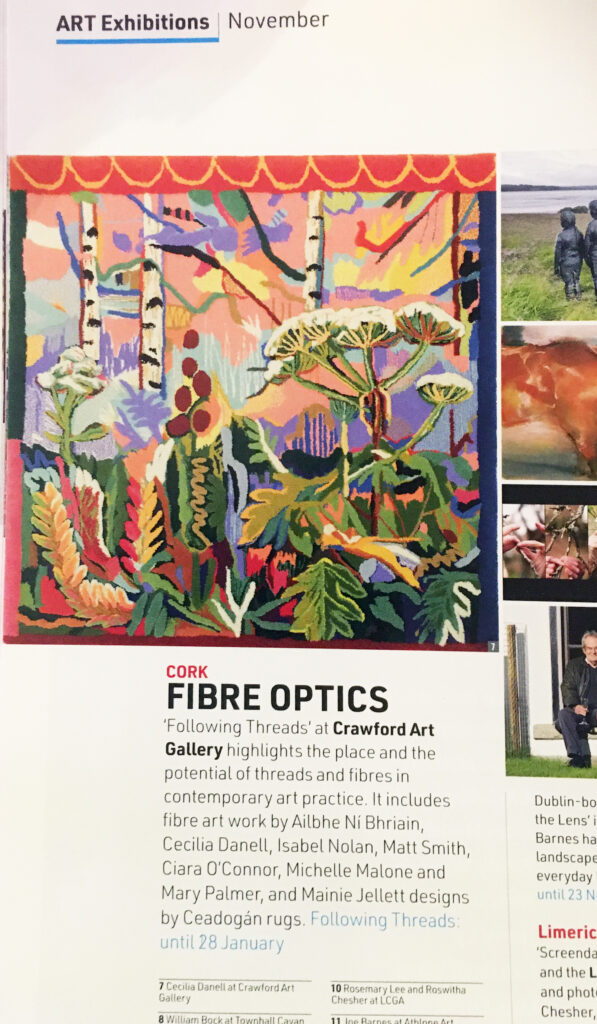
Irish Arts Review, Autumn 2022
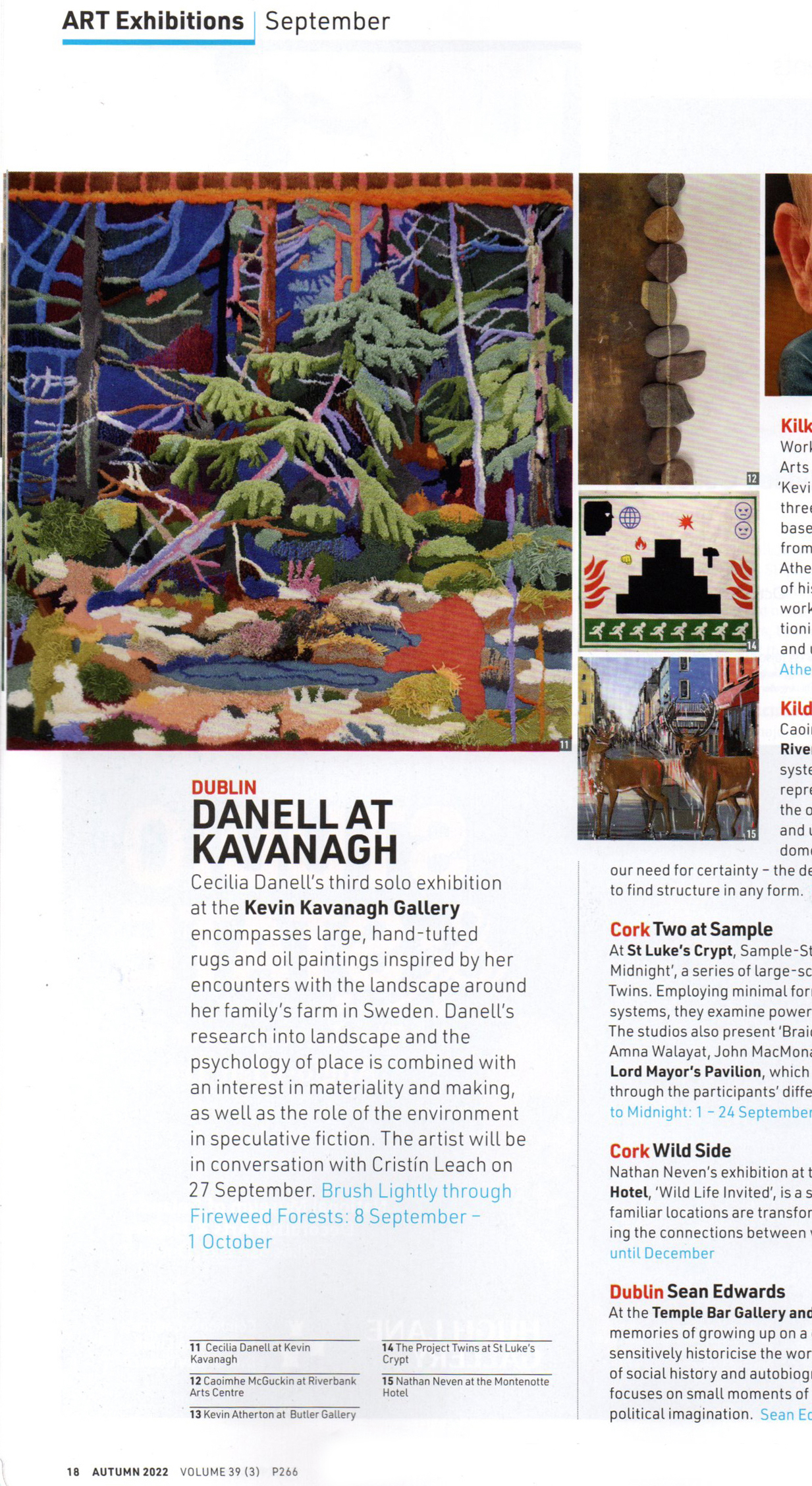
The Sunday Times Culture
By: Cristin Leach
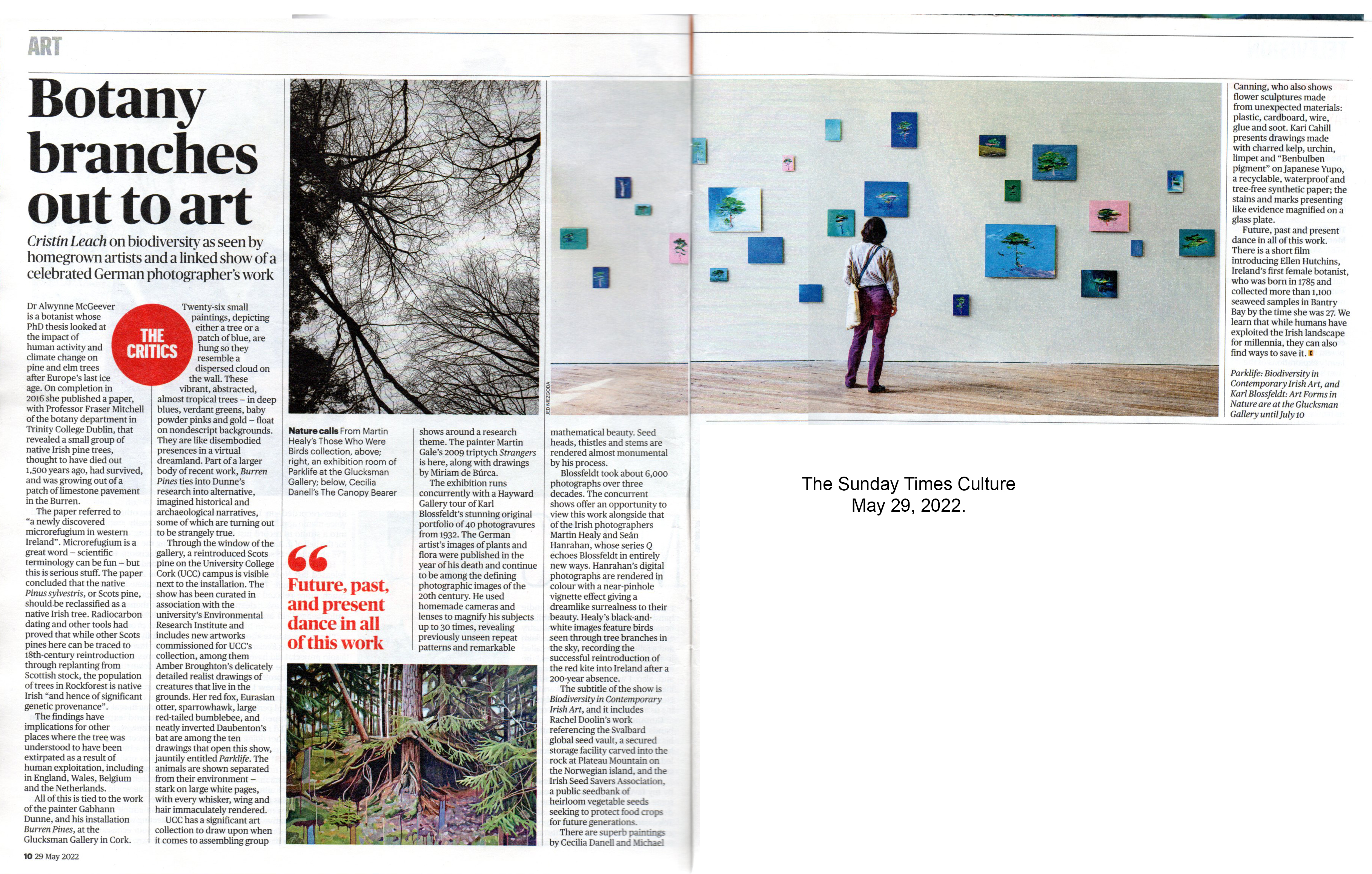
Visual Artists’ News Sheet, March/April 2022
Cecilia Danell and Diana Copperwhite in conversation
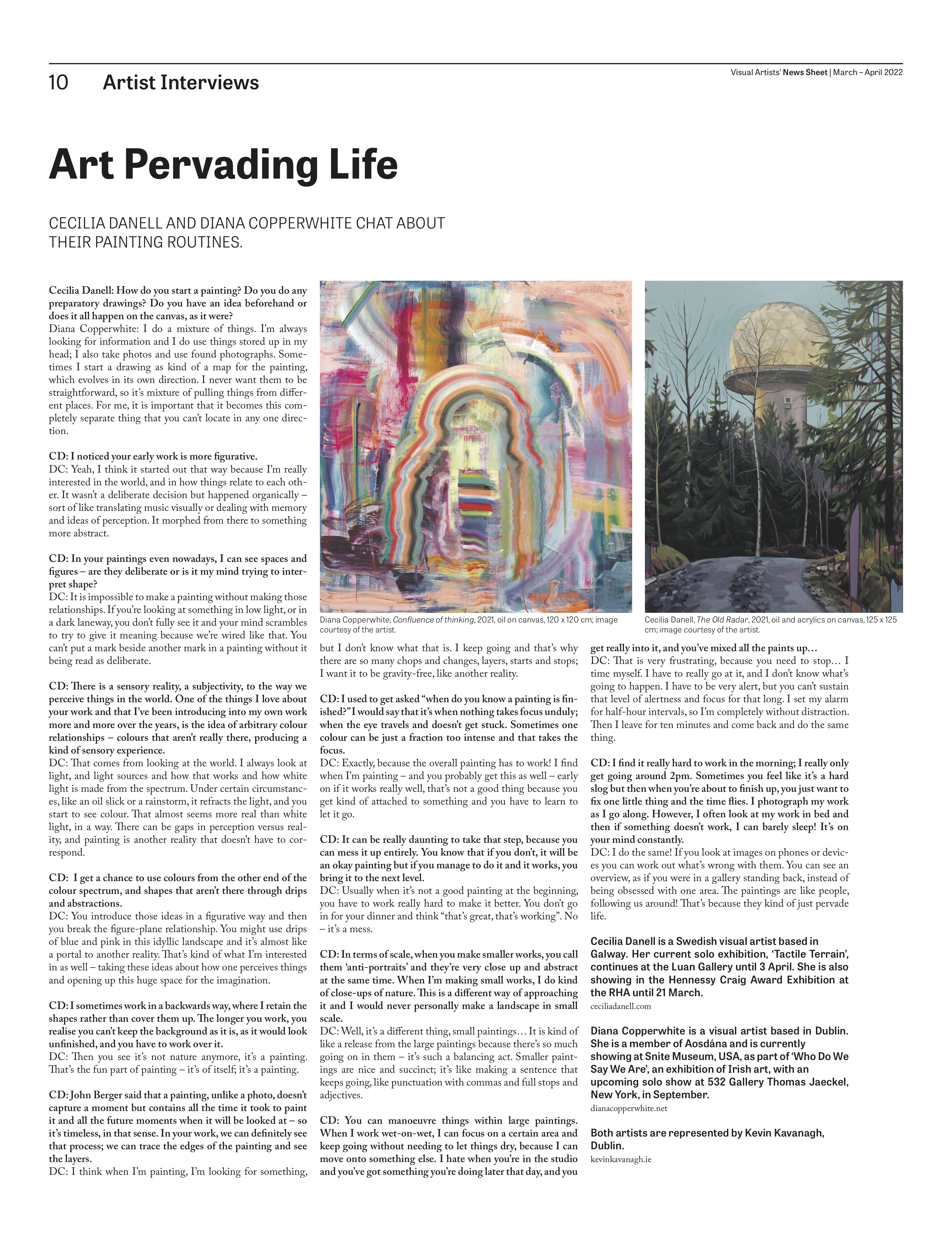
The Galway Advertiser, 10th March 2022
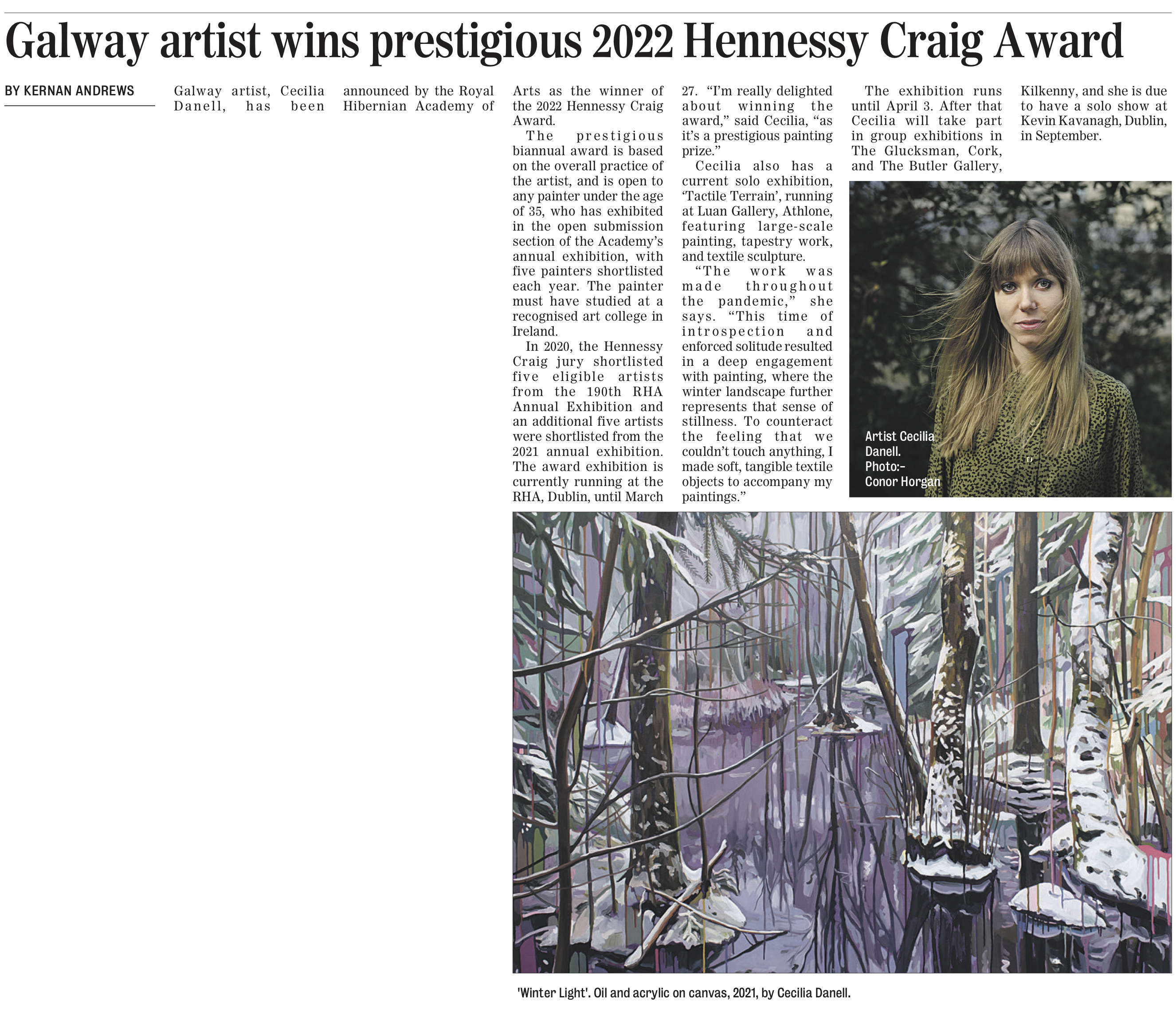
Östgöta Correspondenten, 12th November 2020
By: Fredrik Kylberg
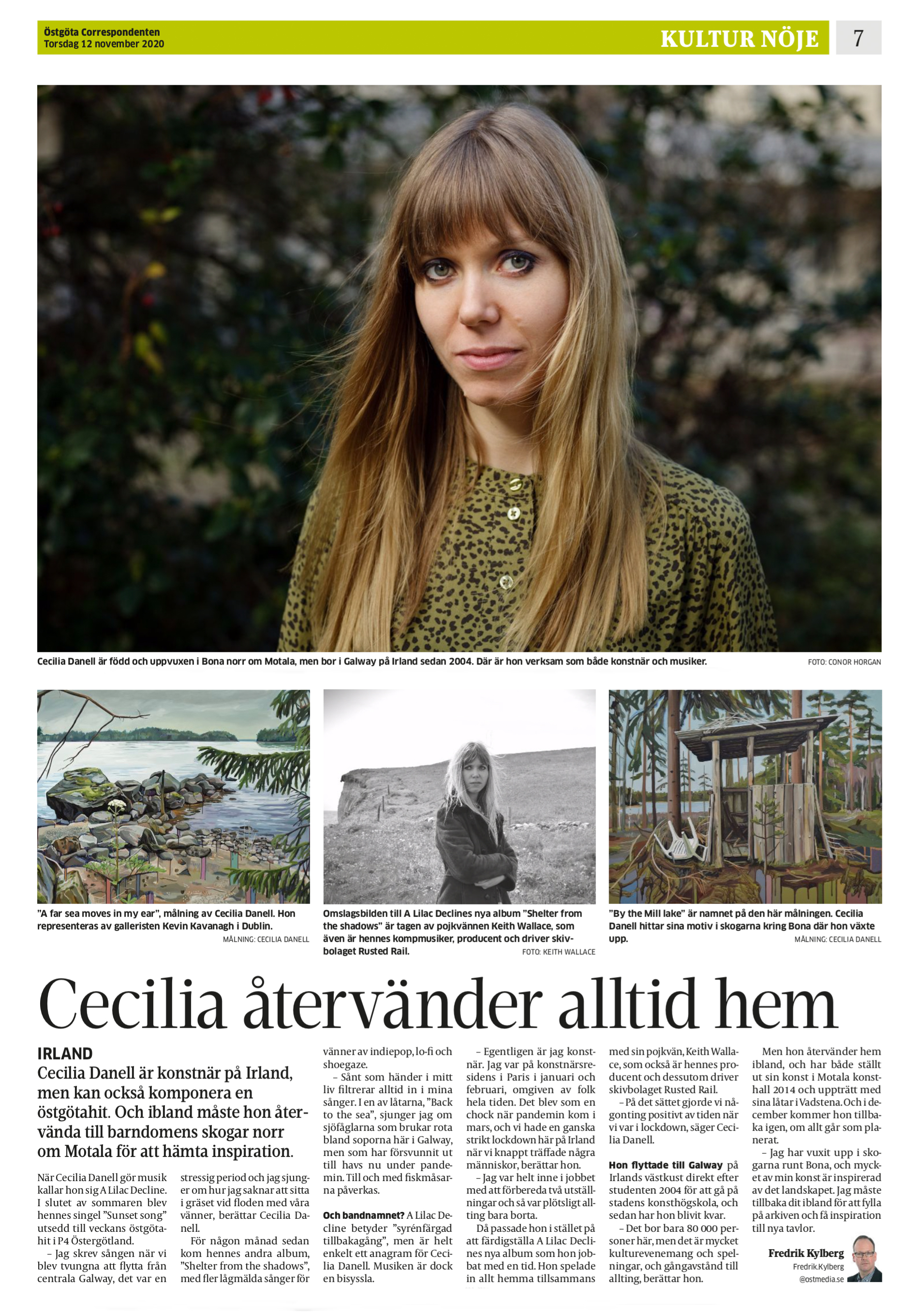
The Irish Times, 23rd March 2019
By: Aidan Dunne
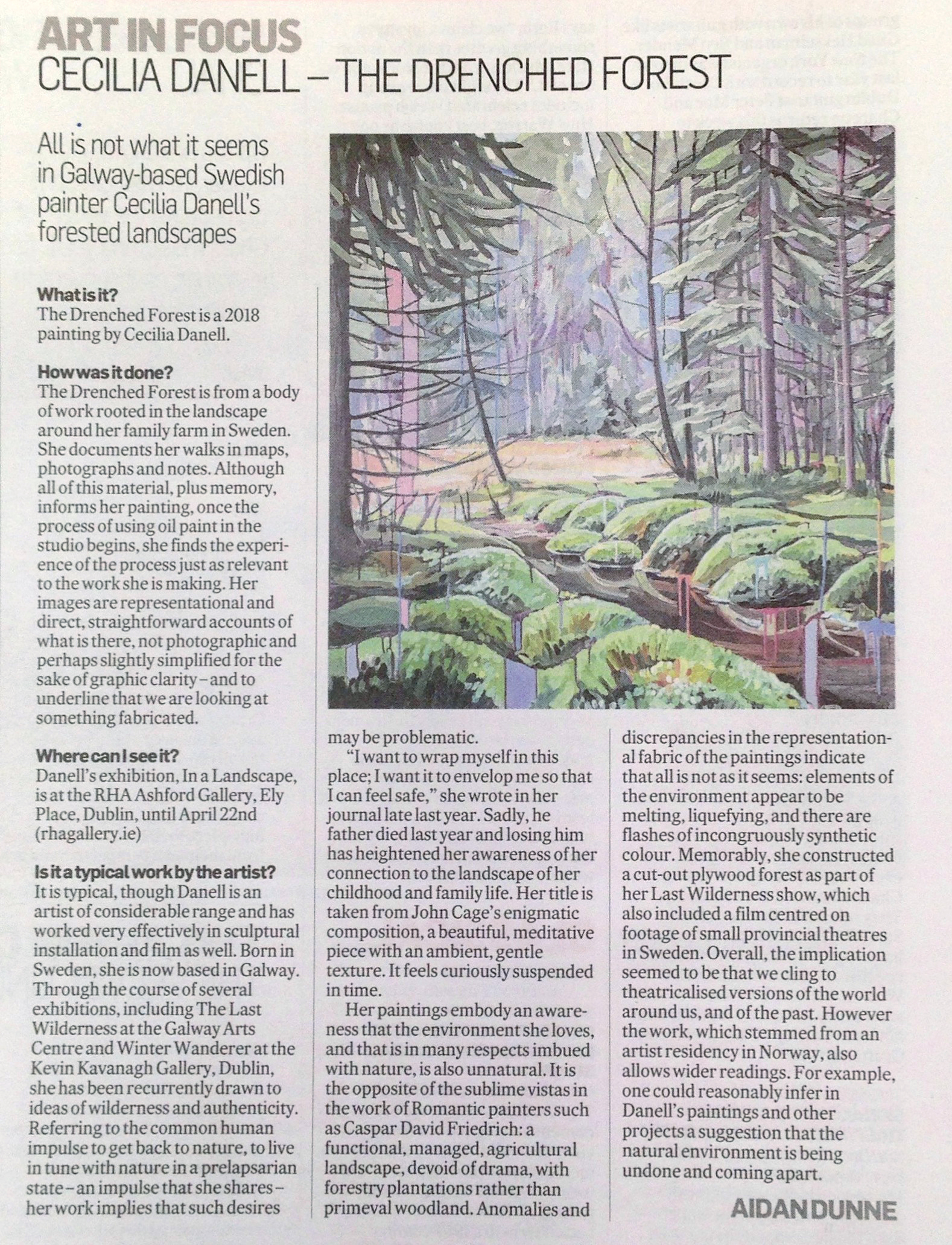
The Sunday Independent, 3rd February 2019
By: Niall MacMonagle
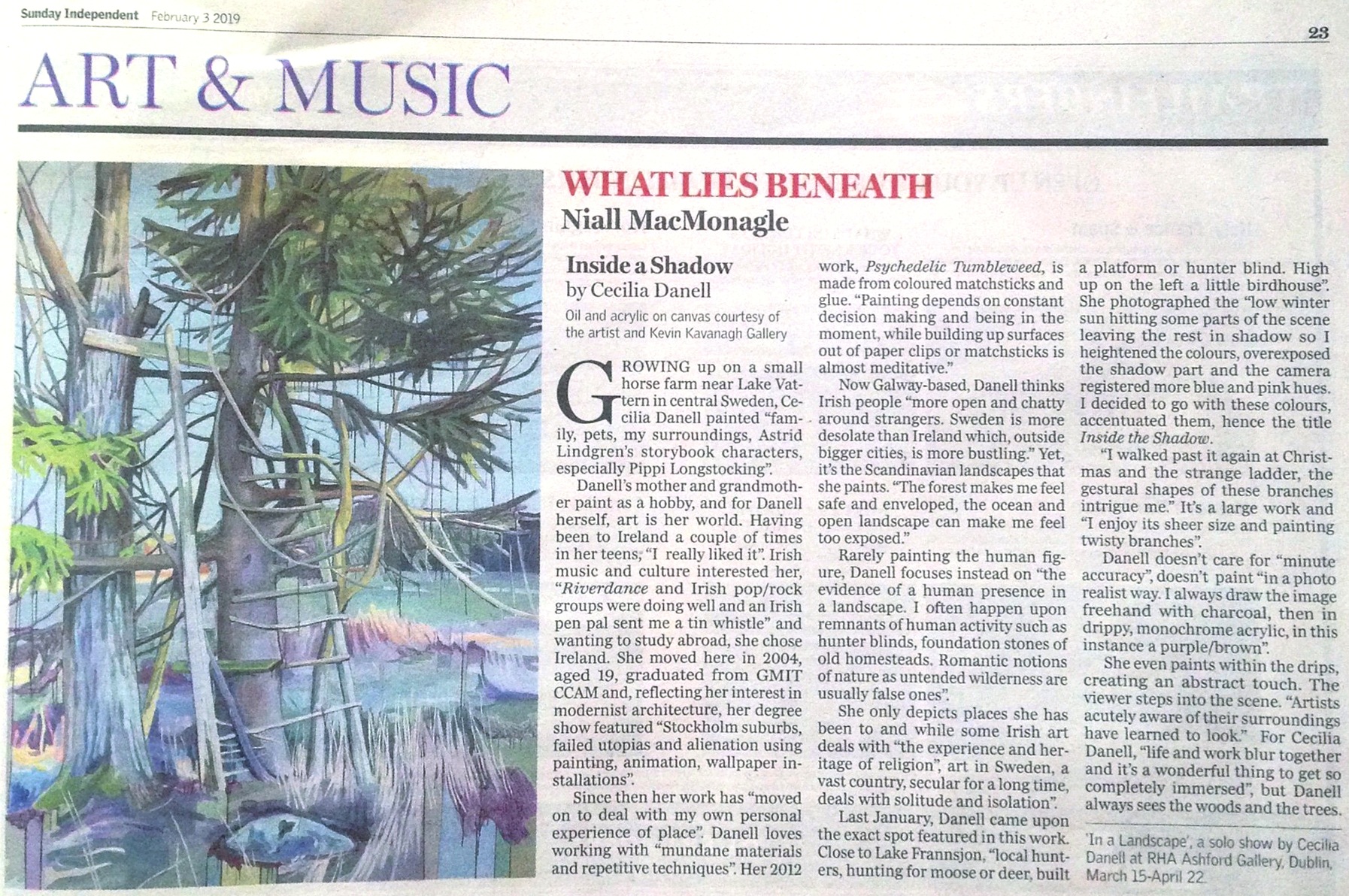
The Irish Times, 27th November 2018
By: Aidan Dunne
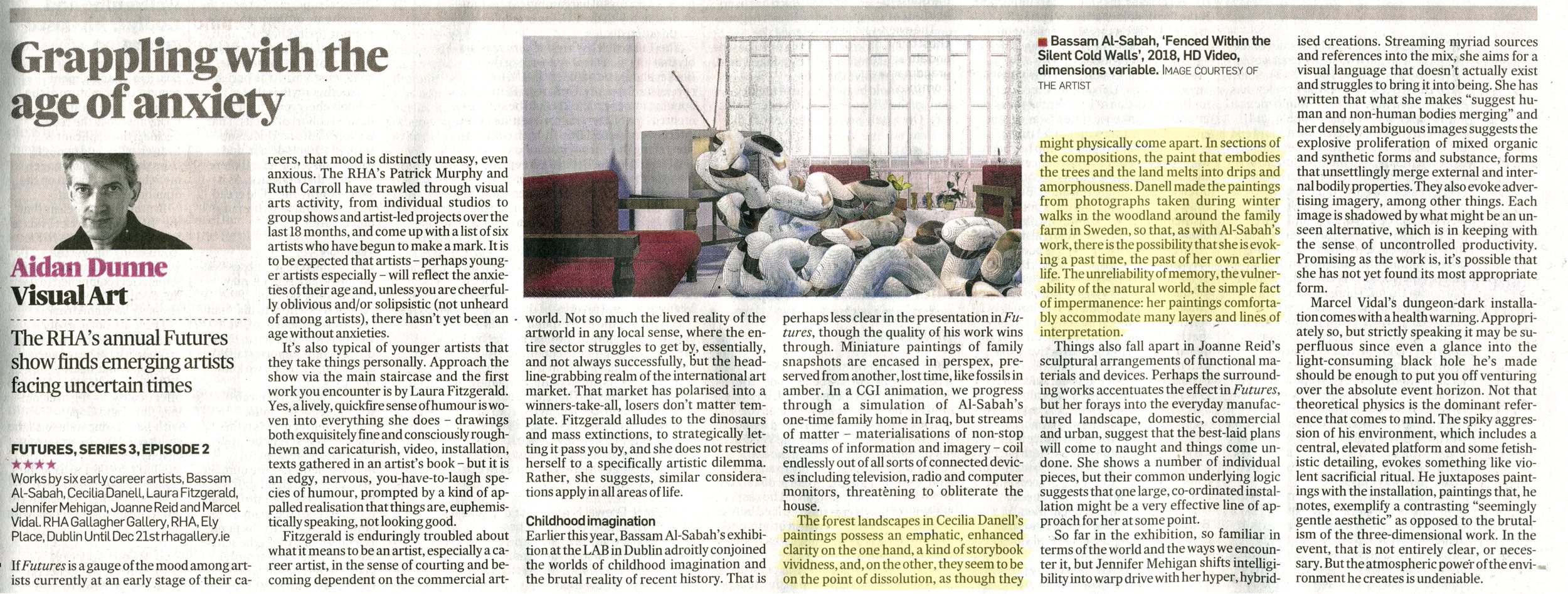
The Sunday Times Culture, 25th November 2018
By: Cristin Leach
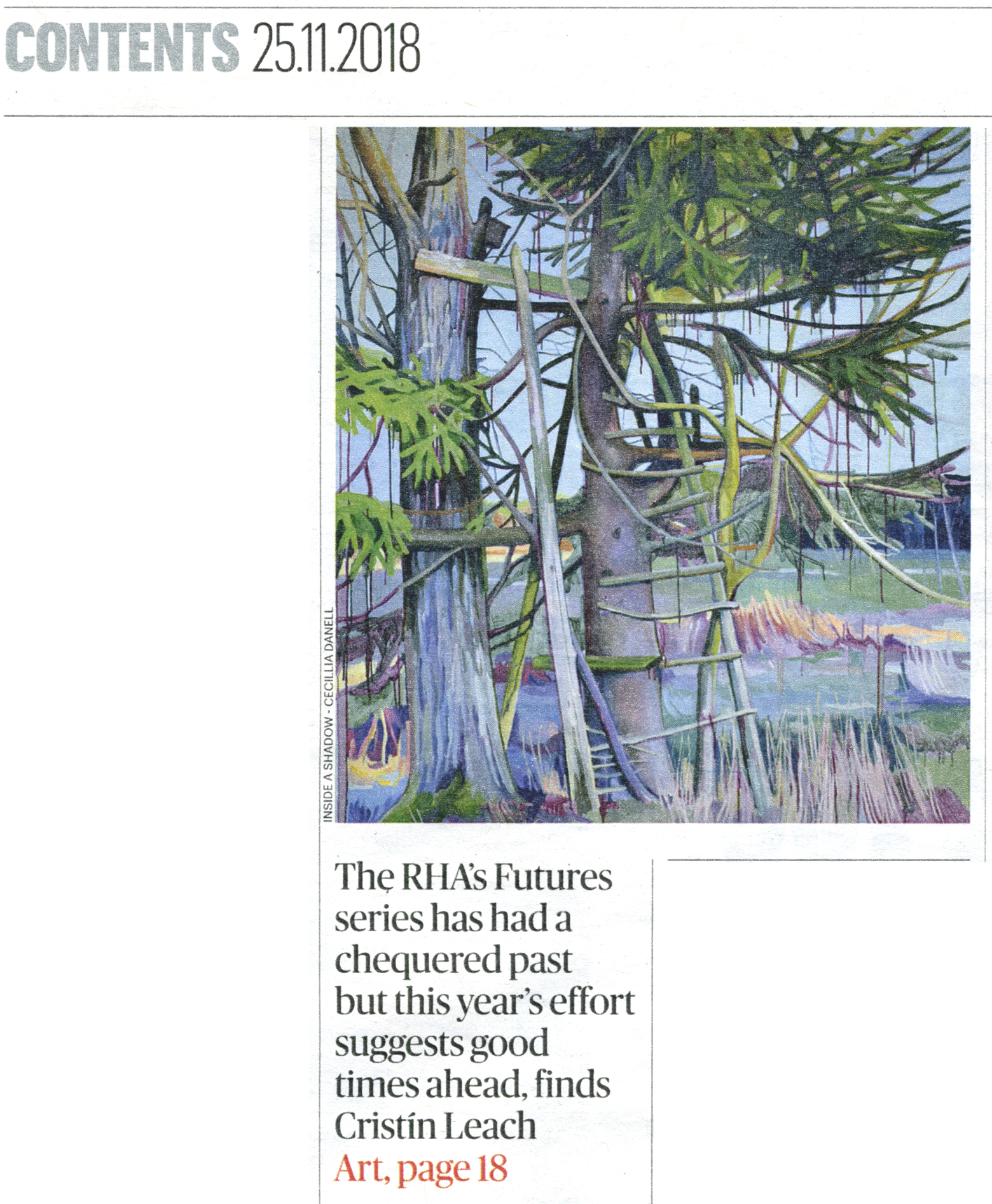
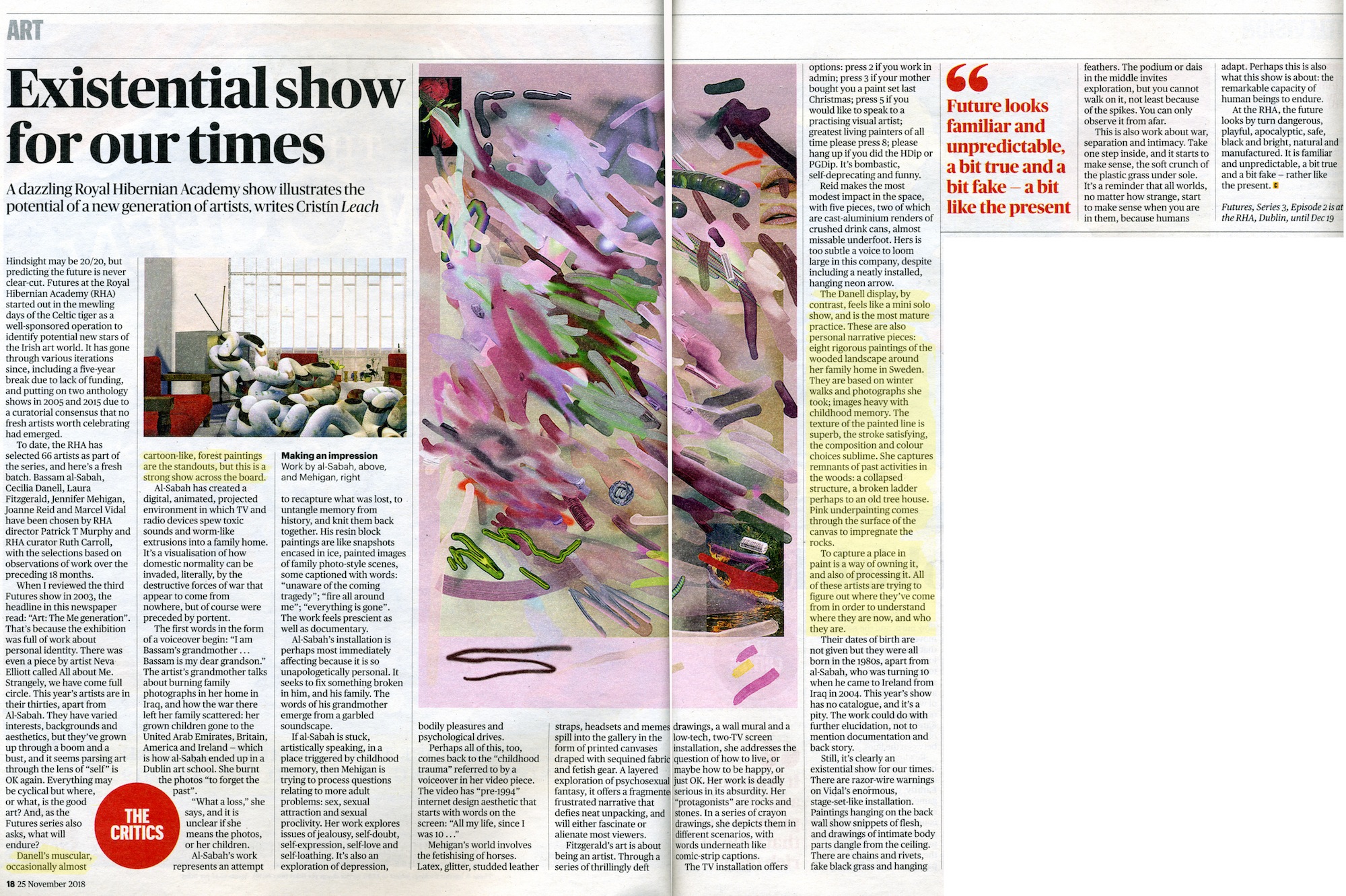
Irish Arts Review, Winter Issue 2018/2019
By: Padraic E Moore
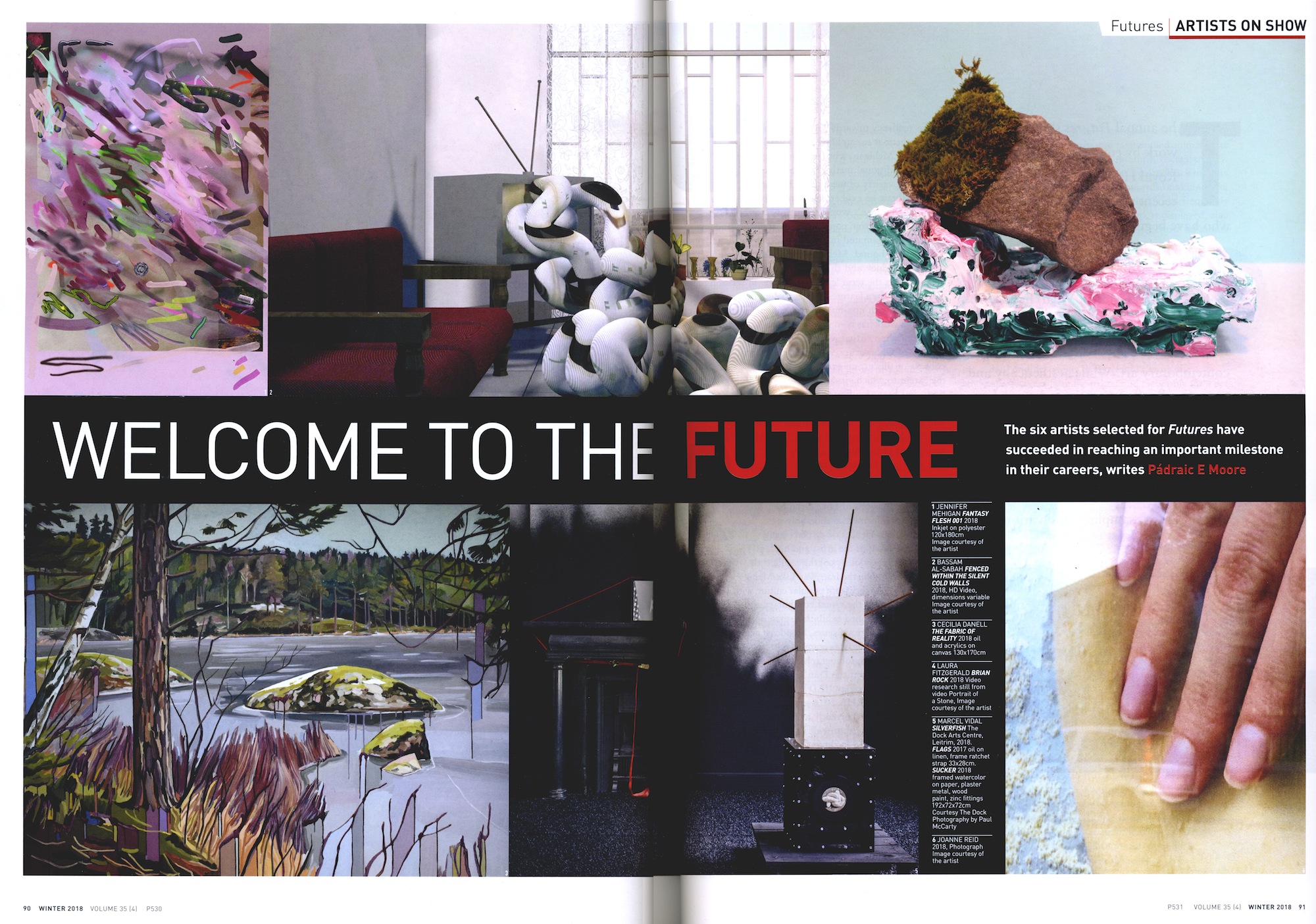
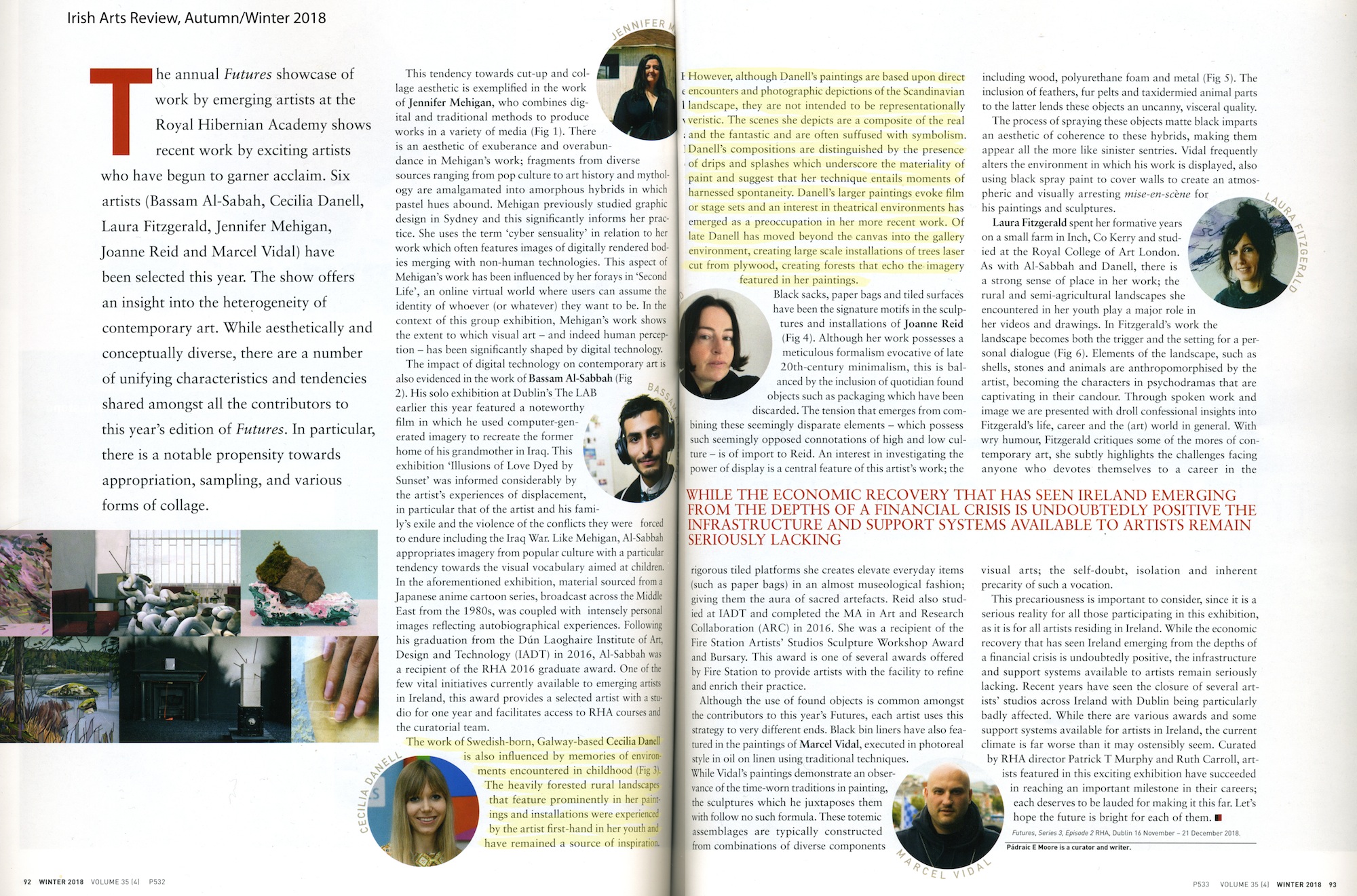
The Galway Advertiser, 15th November 2018
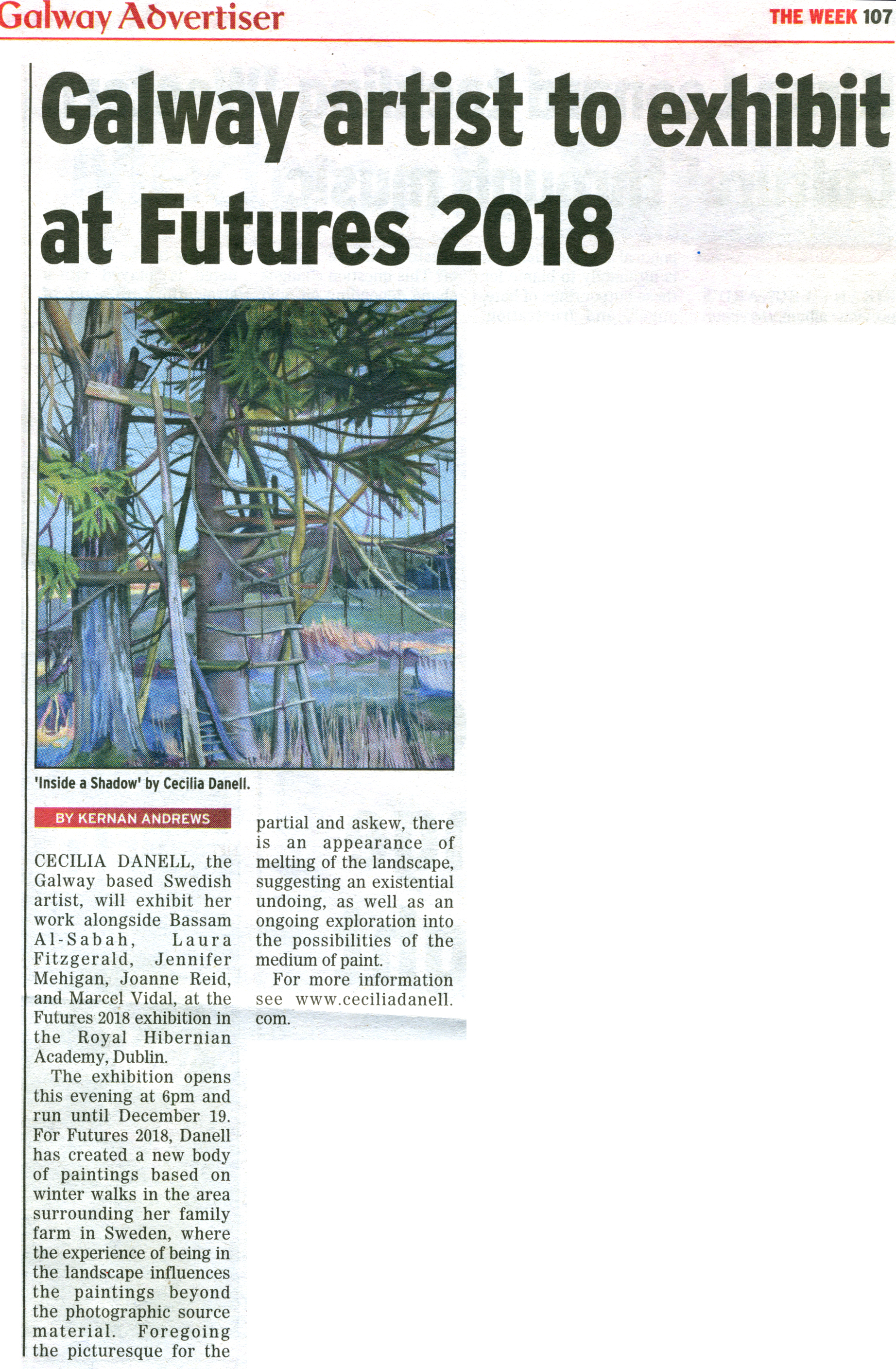
Visual Artists News Sheet, Sept-Oct Issue 2018
By: Joanne Laws
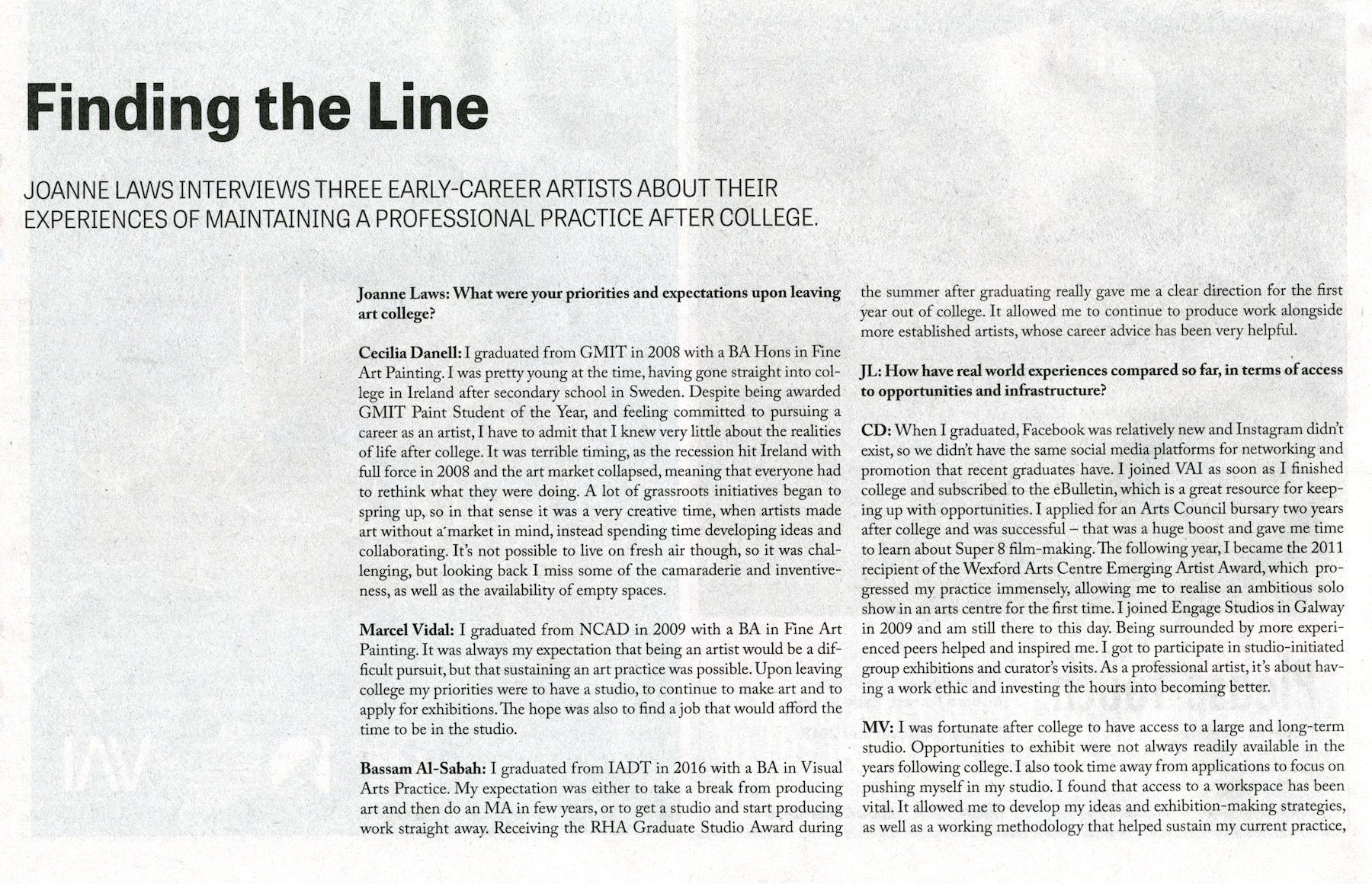
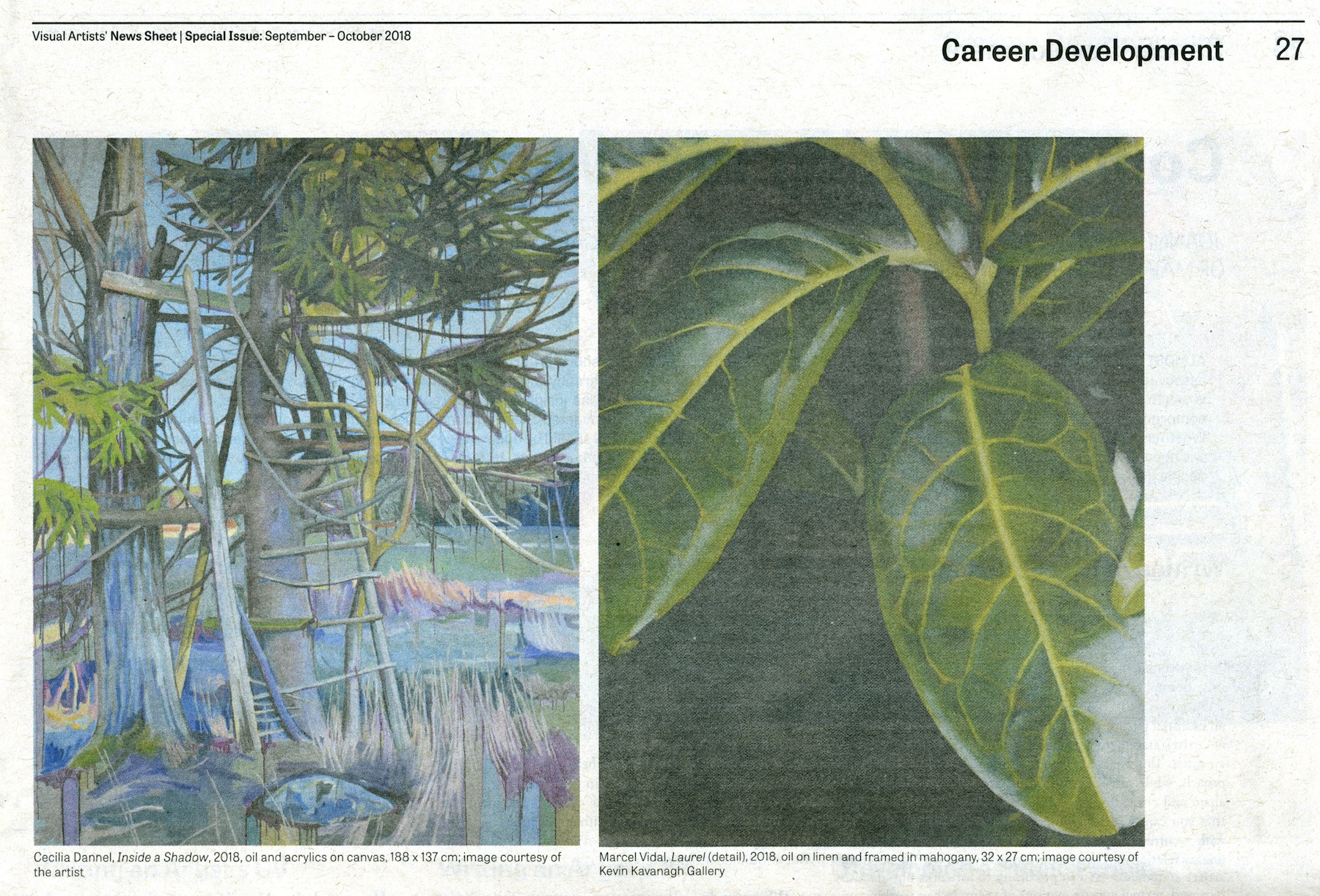
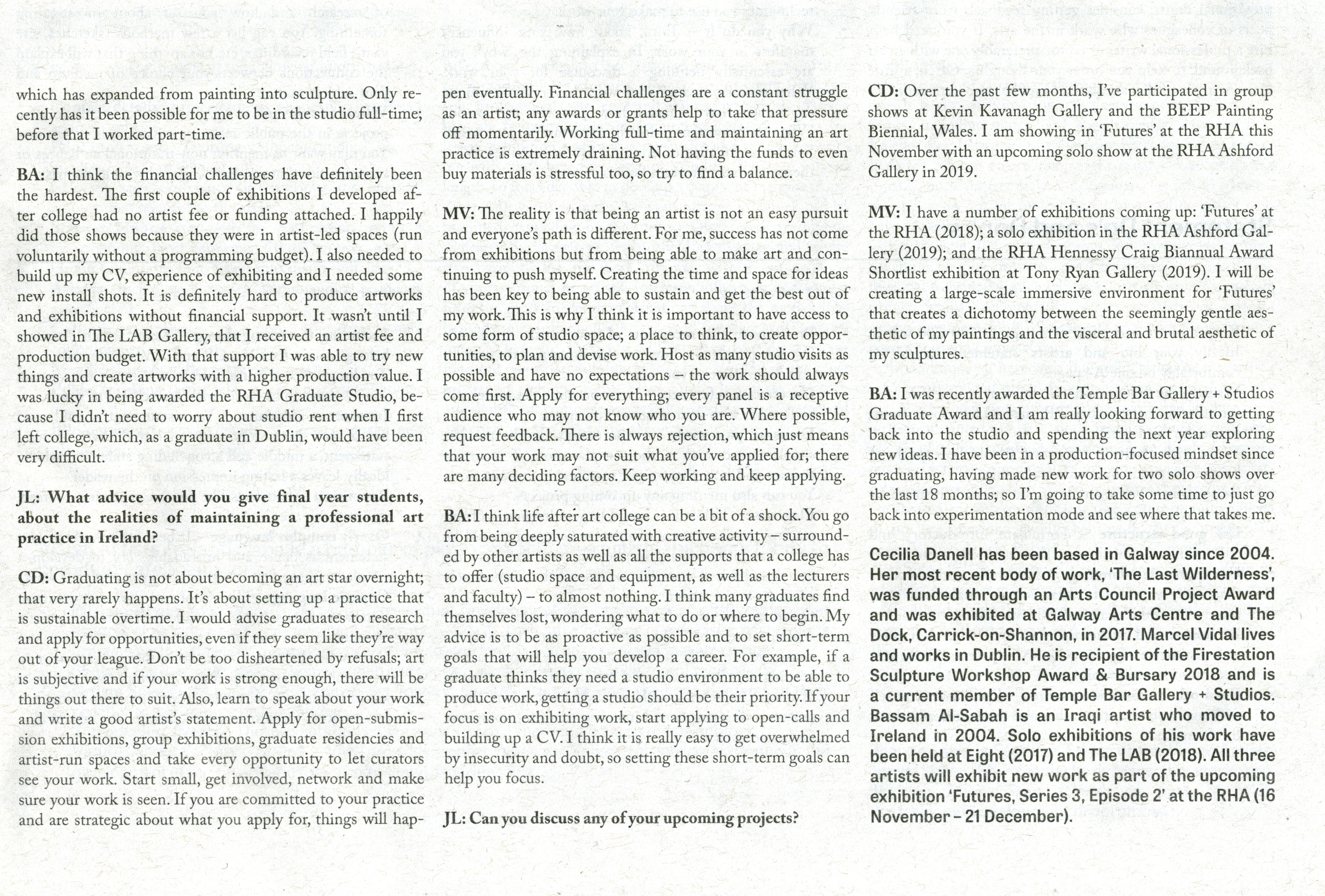
Galway City Tribune, 15th December, 2017.
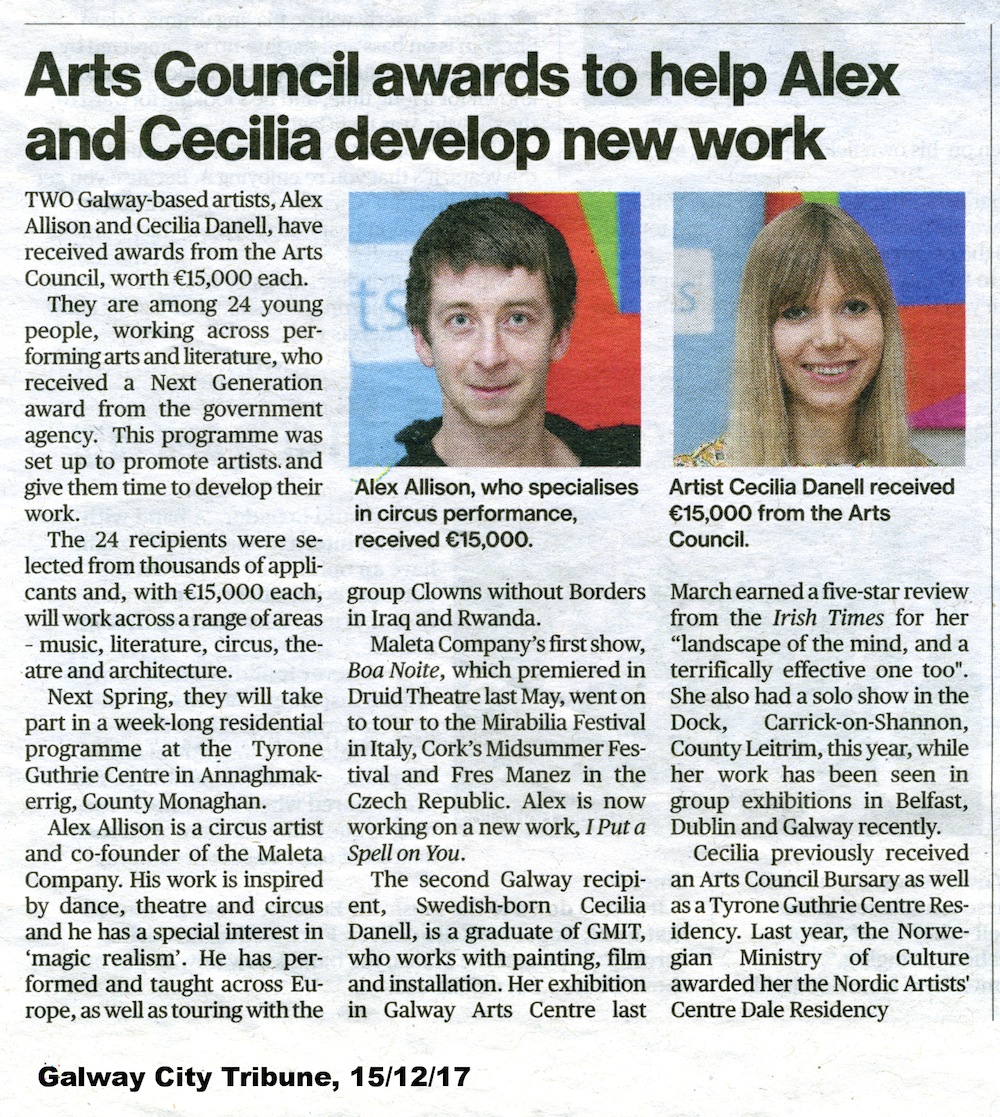
The Irish Times, 28th March 2017.
By: Aidan Dunne.
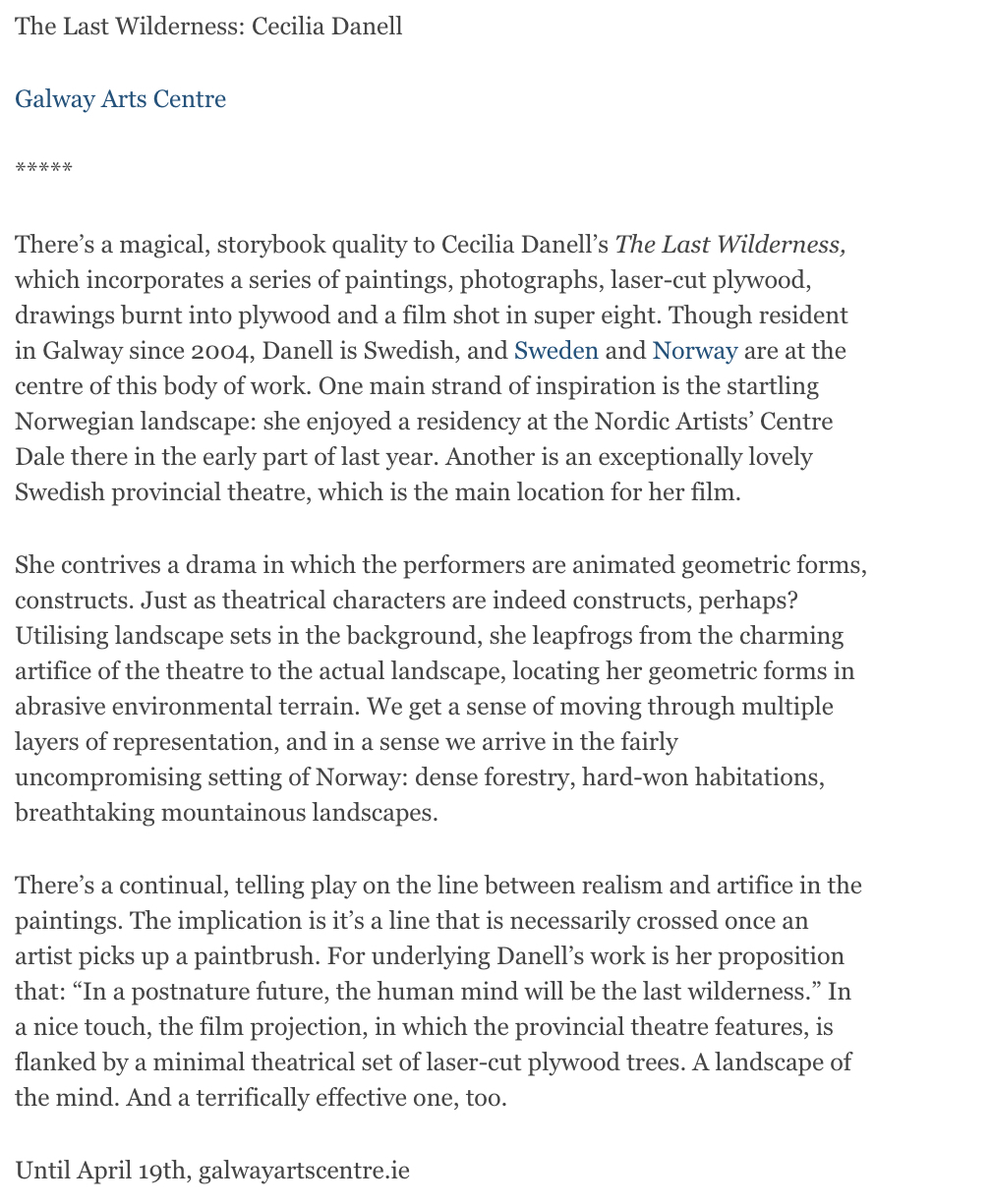
Irish Arts Review, Spring 2017, vol. 34 no. 1.
By: Michaele Cutaya.
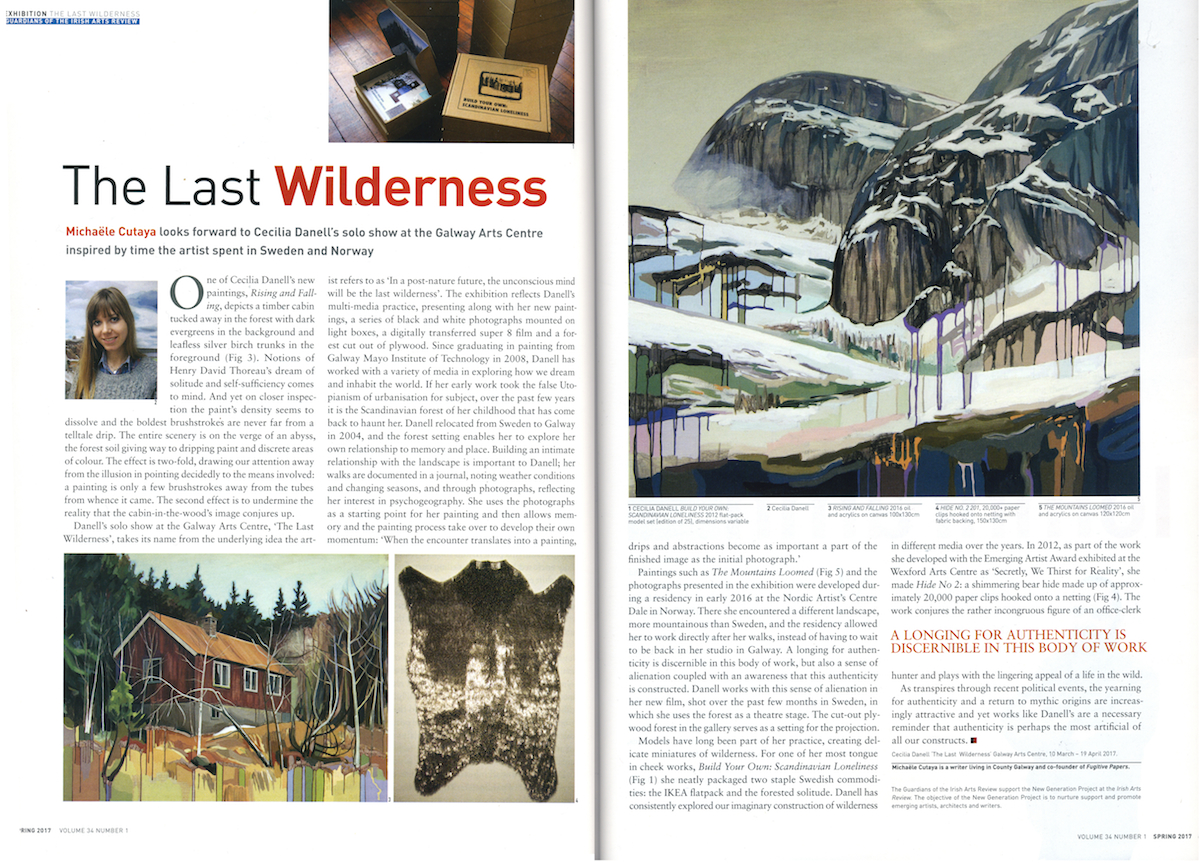
Galway City Tribune, 10th March 2017.
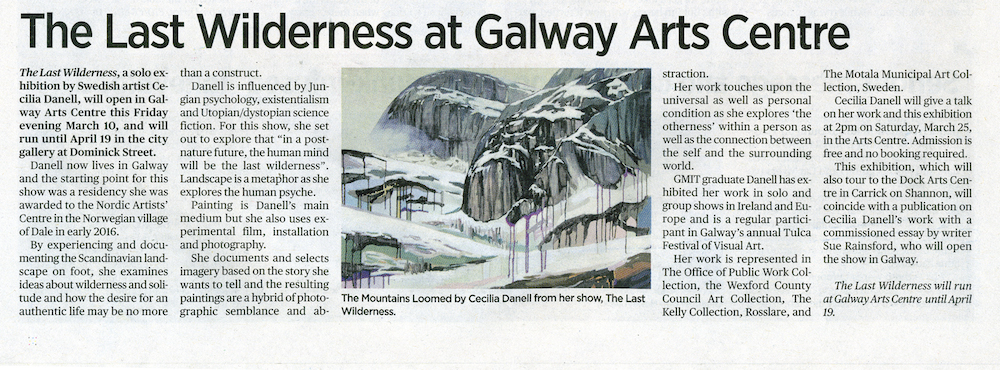
The Galway Advertiser, 9th March 2017.
By: Kernan Andrews.
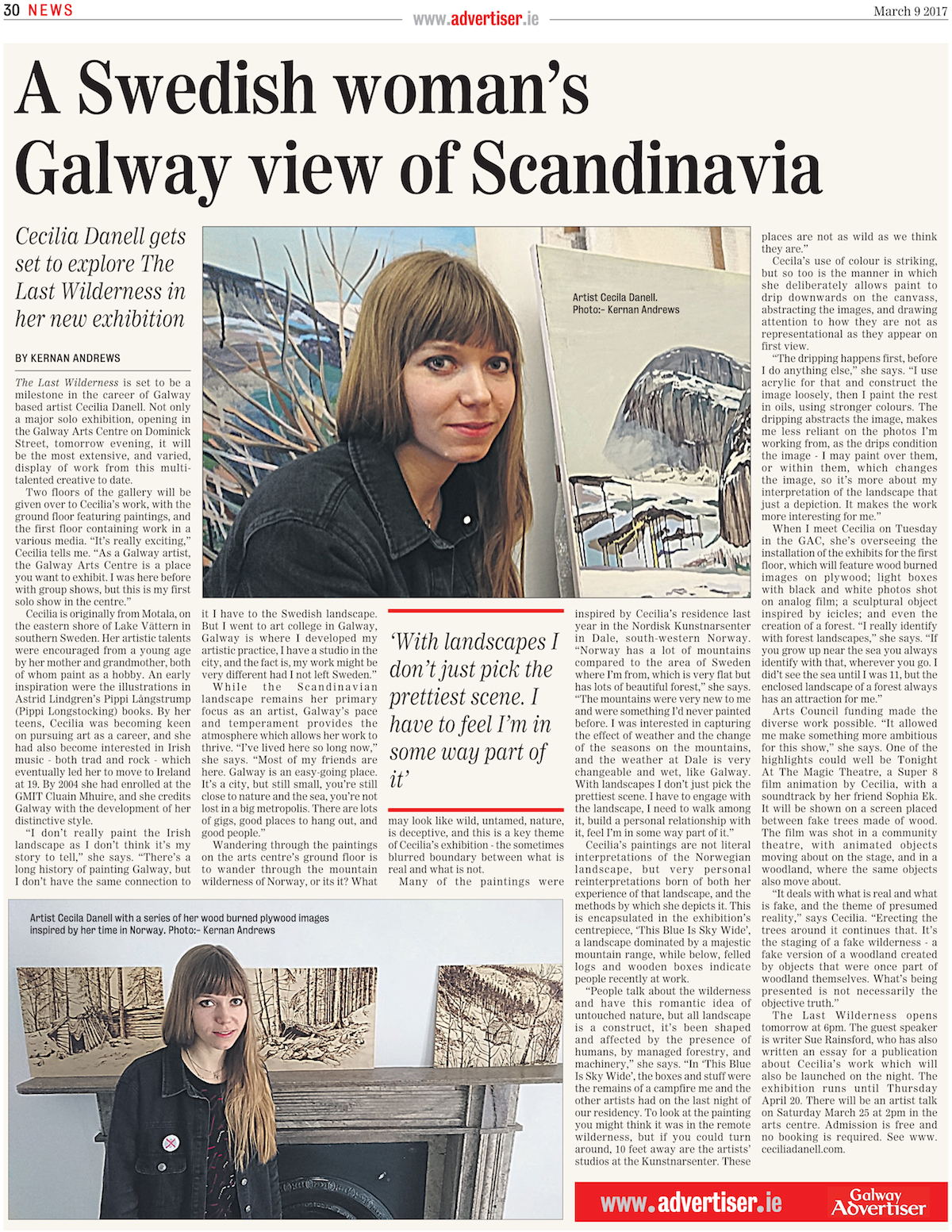
Folio – Vadstenas Kulturtidning, No. 2 Summer 2016.
By: Sofia Ek.
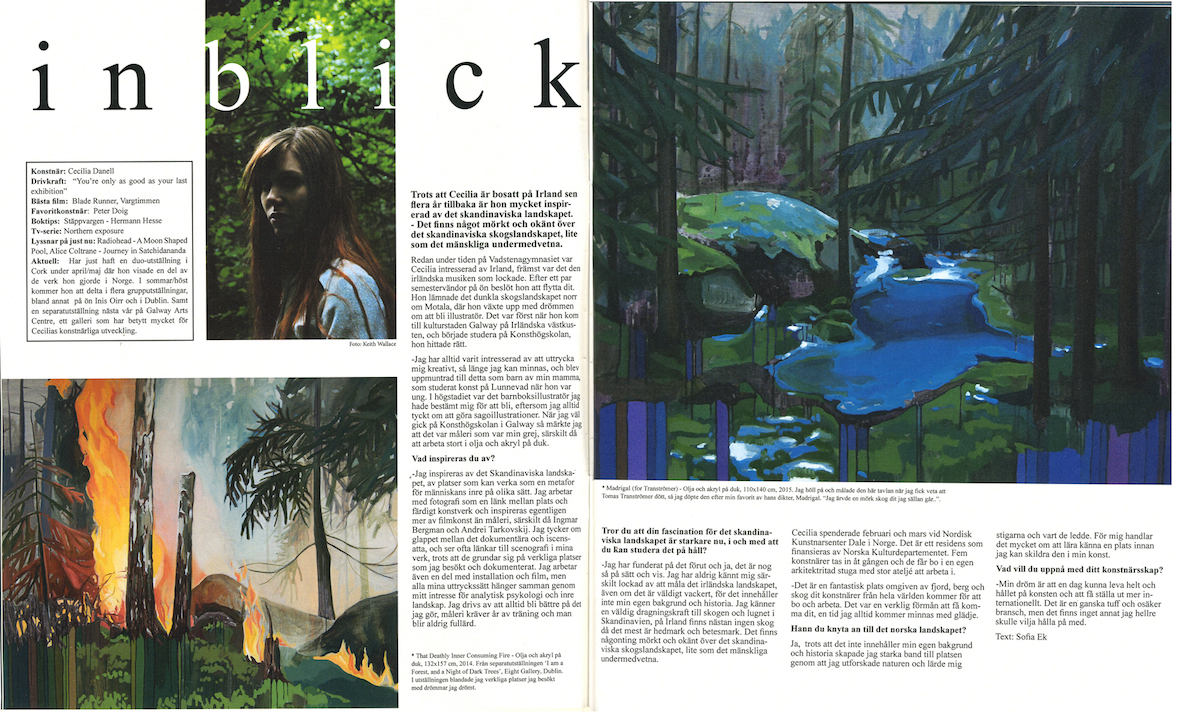
The Galway Advertiser, 21st July 2016.
By: Kernan Andrews.
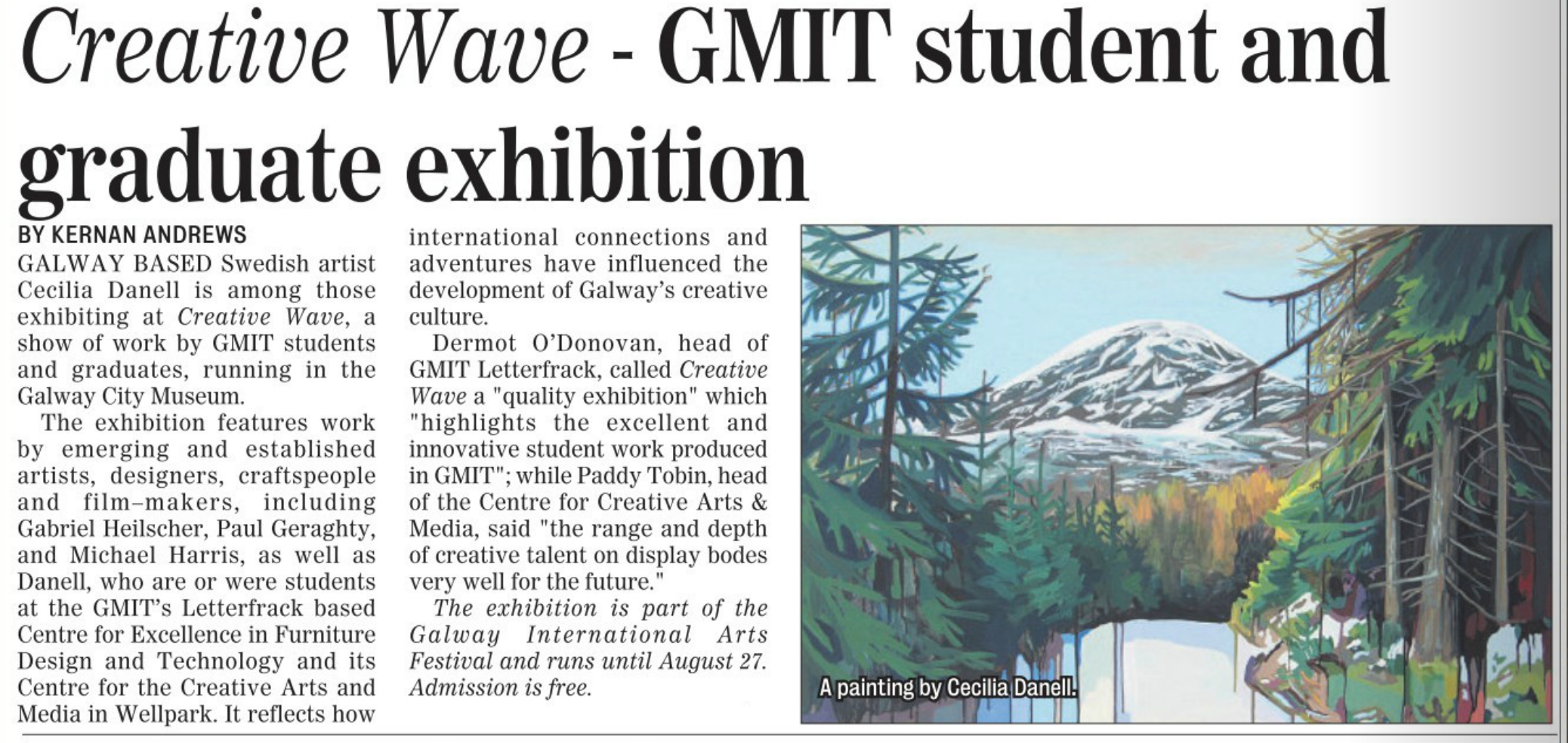
The Galway Advertiser, 13th November 2014.
By: Kernan Andrews. Photo: Mike Shaughnessy
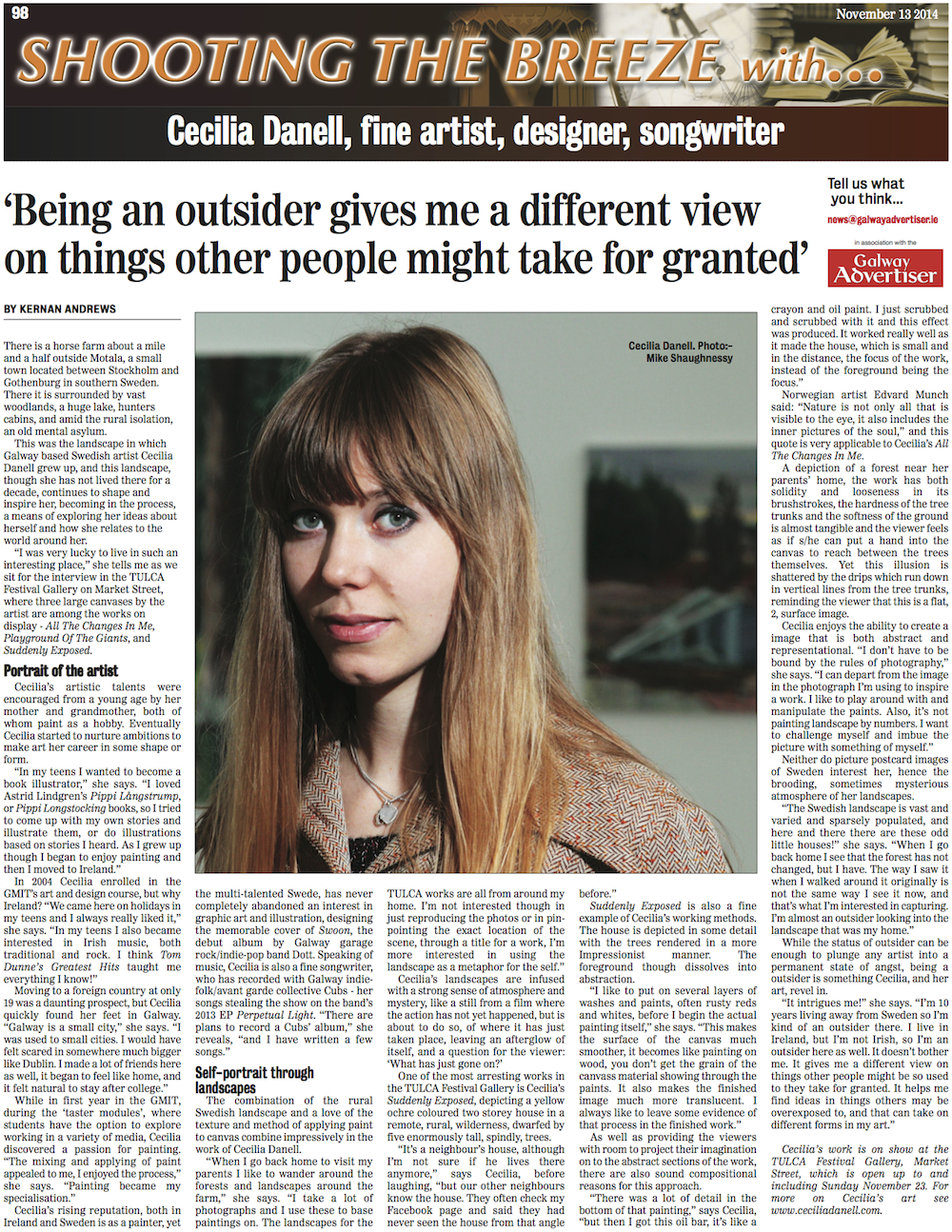
Motala & Vadstena Tidning, 11th January 2014.
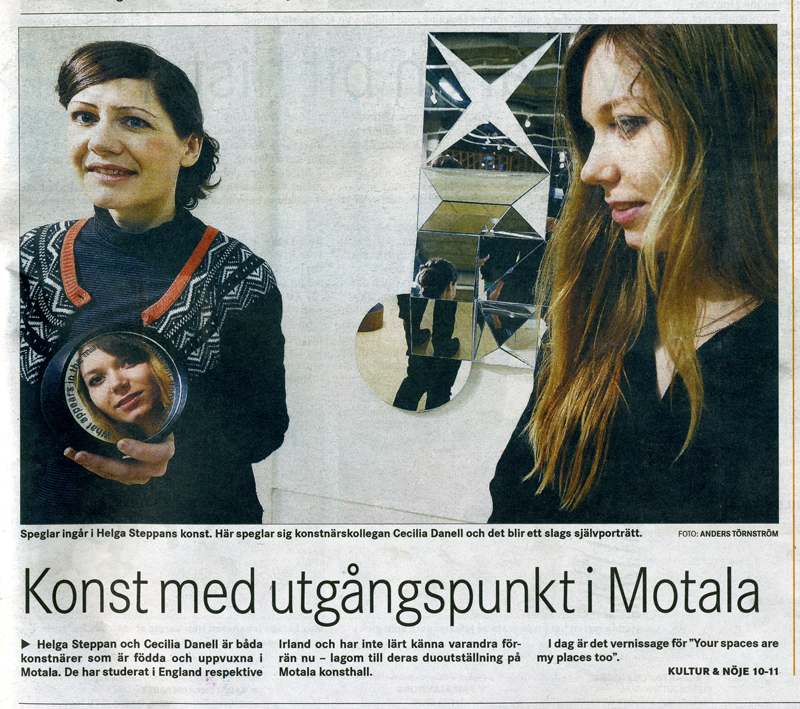
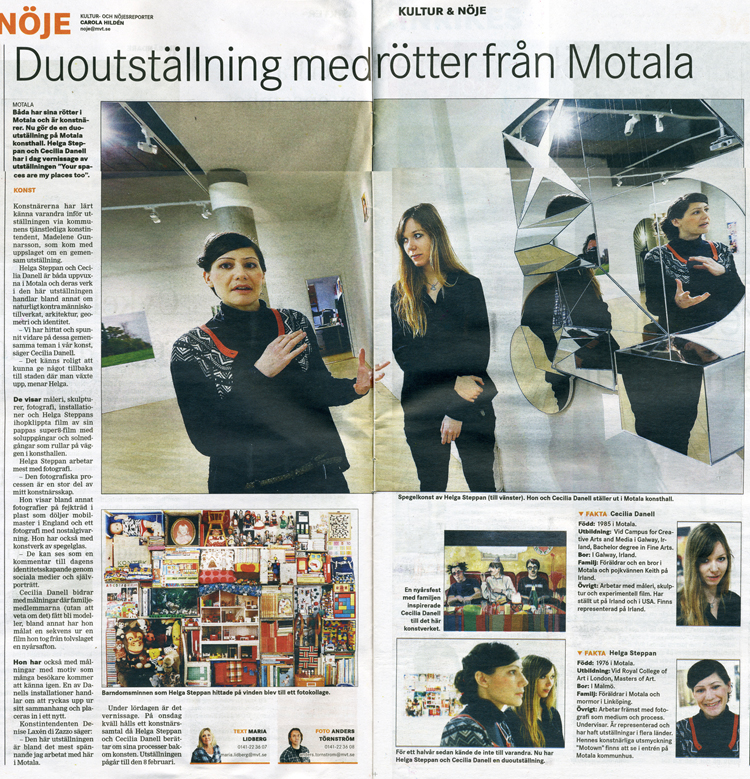
Both have their roots in Motala and are artists. Now they’re doing a two person exhibition at Motala Konsthall. Today the opening reception takes place of Helga Steppan’s and Cecilia Danell’s joint exhibition Your Spaces are my Places too.
By: Maria Lidberg. Photos: Anders Törnström
Duo exhibition with roots in Motala
The artists have come to know each other ahead of the exhibition through the council’s arts officer, Madelene Gunnarsson, who is currently on leave, and she suggested they do a joint exhibition. Helga Steppan and Cecilia Danell both grew up in Motala and their artworks in this exhibition deal with the natural versus the man-made, architecture, geometry and identity, amongst other things. ‘We have found and developed these common themes in our art’ says Cecilia Danell. ‘It’s fun to give something back to the town where you grew up’ says Helga.
They’re showing painting, photography, installation and Helga Steppan’s film she’s edited together from her dad’s Super 8 footage of sunrises and sunsets, which is projected on the wall. Helga Steppan prefers to work with photography. ‘The photographic process is a large part of my practice’. She shows, amongst other things, pictures of fake trees made of plastic which hide mobile phone masts in England and a photograph which brings on nostalgia. She is also showing works made out of mirror glass. ‘They can be seen as a comment on today’s identity creation through social media and self portraits’. Cecilia Danell contributes with paintings where family members have become her models (unknowingly), she has painted a still from a film she shot when the clock struck 12 one New Year’s Eve.
She is also showing paintings with motifs the visitors will recognise. One of Danell’s installations is about being uprooted from one context and being placed into a a new one. Acting arts officer Denise Laxen di Zazzo says: ‘This exhibition is one of the most exciting things I’ve worked with here in Motala’. On Saturday the opening takes place, on Wednesday evening there will be an artist talk where Helga Steppan and Cecilia Danell talk about their processes behind the art. The exhibition continues until the 8th February.
Östgötatidningen Motalamagasinet 15th January 2014.
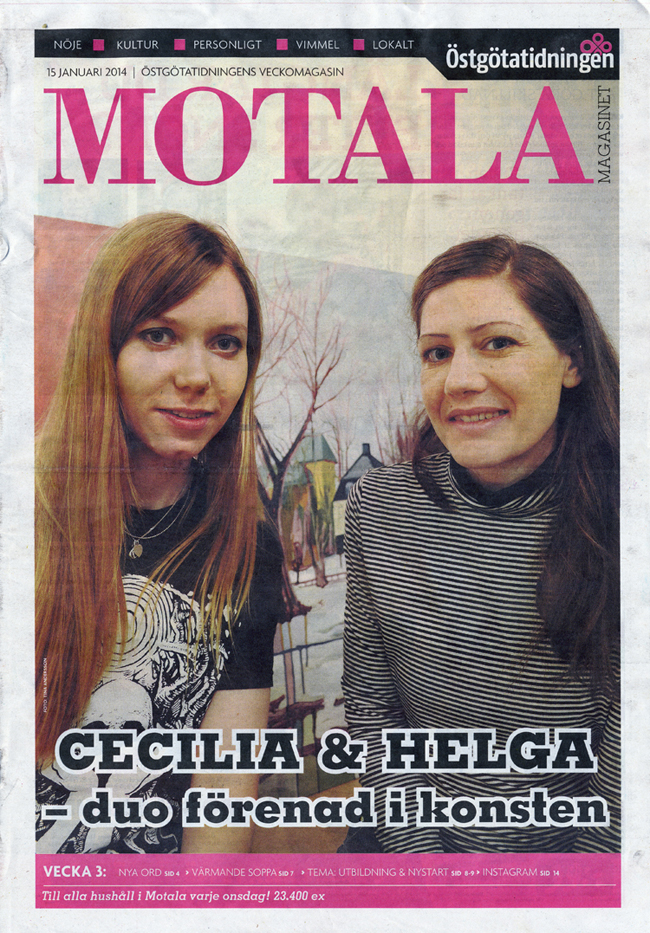
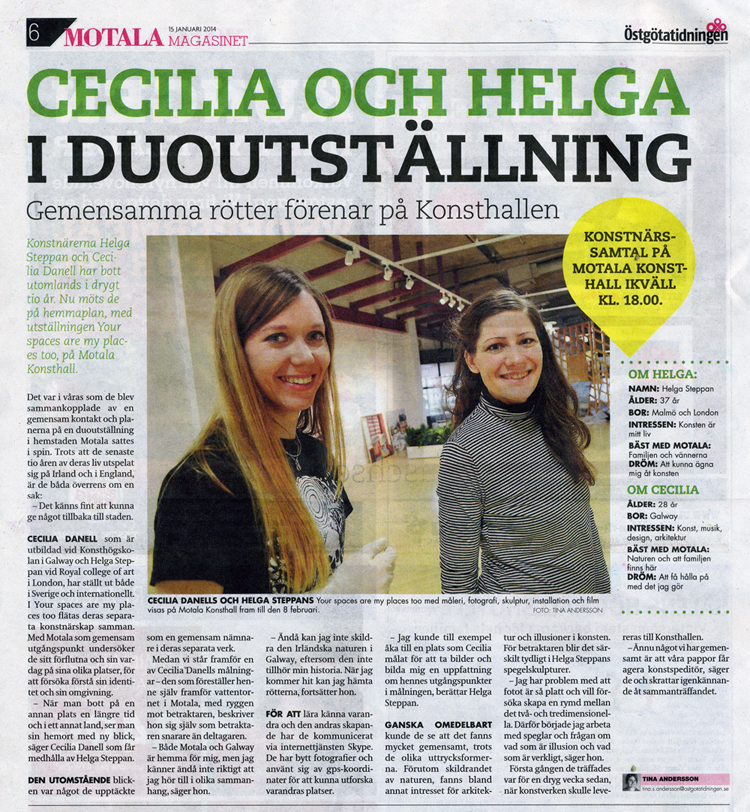
Artists Helga Steppan and Cecilia Danell have lived abroad for just over ten years. Now they meet at home with the exhibition Your Spaces are my Places too at Motala Konsthall.
By: Tina Andersson
Cecilia and Helga in duo exhibition
– Shared roots unite in the Arts Centre.
They got put together last spring by a shared contact and the plans of a two person exhibition in their hometown Motala began to take shape. Despite having spent the past ten years of their lives in Ireland and England, they both agree on one thing: It feels good to be able to give something back to the town.
Cecilia Danell who studied at the Art College in Galway and Helga Steppan who studied at the Royal College of Art in London, have exhibited both in Sweden and internationally. In Your Spaces are my Places too their separate artistic practices are woven together. With Motala as their shared starting point they investigate their past and their everyday lives in their separate places in order to understand their identity and environment. ‘When one has lived in a different place for a longer period of time and in a different country, one starts to look upon one’s home place with new eyes’, says Cecilia Danell and Helga Steppan agrees.
The outside gaze was something they both found to be a common thread in their separate works. When we stand in front of Cecilia’s paintings, which represent herself in front of the water tower in Motala and with her back towards the viewer, she describes herself as a watcher rather than a partaker. ‘Both Motala and Galway is home for me, but I still feel that I don’t quite belong in different situations’, she says. ‘Yet I can’t depict the Irish scenery in Galway, since it’s not part of my own history’, she continues.
To get to know each other and each other’s creative processes they’ve communicated via Skype. They have exchanged photographs and used GPS-coordinates to explore each other’s places. ‘I could for example go to a place that Cecilia has painted to take pictures and get to know the starting points for her painting’, says Helga Steppan.
More or less immediately, they could see a lot of things that they had in common, despite their different modes of expression. Apart from the depiction of nature, there was amongst other things the interest in architecture and illusions in art. For the viewer this becomes particularly obvious in Helga Steppan’s mirror sculptures. ‘I have a problem with photographs being very flat and want to try and create volume between the two and three dimensional. That’s why I started to work with mirrors and the question of what’s illusion and what’s real’, she says. The first time they met in real life was just over a week ago, when the artworks were to be delivered to the arts centre. ‘Another thing we have in common is how our dads get to act as art movers’, they say and laugh in recognition at the coincidence.
The Wexford Echo Newspaper, 4th December 2012.
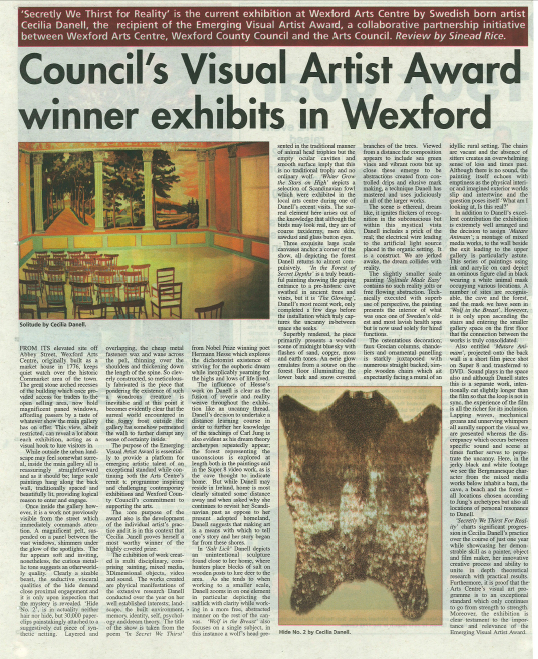
‘Secretly we thirst for reality’ is the current exhibition at Wexford Arts Centre by Swedish born artist Cecilia Danell, the recipient of the Emerging Visual Artist Award, a collaborative partnership between Wexford Arts Centre, Wexford County Council and the Arts Council.
Review by: Sinead Rice.
Council’s Visual Artist Award winner exhibits in Wexford
From its elevated site on Abbey Street, Wexford Arts Centre, originally built as a market house in 1776, keeps quiet watch over the historic Cornmarket area of the town. The great stone arched recesses of the building which once provided access for trades to the open selling area, now holds magnificent paned windows, affording passers by a taste of whatever show the main gallery has on offer. This view, albeit restricted, can reveal a lot about each exhibition, acting as a visual hook to lure visitors in.While outside the urban landscape may feel somewhat surreal, inside the gallery all is reassuringly straightforward and as it should be; large scale paintings hang along the back wall, traditionally spaced and beautifully lit, providing logical reason to enter and engage.
Once inside the gallery however, is is a work not previously visible from the street which immediately commands attention. A magnificent pelt, suspended on a panel between the vast windows, shimmers under the glow of the spotlights. The fur appears soft and inviting, nonetheless, the curious metallic tone suggests an otherworldly quality. Clearly a sizeable beast, the seductive visceral qualities of the hide demand close proximal engagement and it is only upon inspection that the mystery is revealed, ‘Hide no. 2’, is in actuality neither hair nor hide, but 30 000 paperclips painstakingly attached to a suggestively cut piece of synthetic netting. Layered and overlapping, the cheap metal fasteners wax and wane across the pelt, thinning over the shoulders and thickening down the length of the spine. So cleverly constructed, so meticulously fabricated is the piece that pondering the existence of such a wondrous creature is inevitable and at this point it becomes evidently clear that the surreal world encountered in the foggy frost outside the gallery has somehow permeated the walls to further disrupt any sense of certainty inside.
The purpose of the Emerging Visual Artist Award is essentially to provide a platform for emerging artistic talent of an exceptional standard while continuing both the Art Centre’s remit to programme inspiring and challenging contemporary exhibitions and Wexford County Council’s commitment to supporting the arts. The core purpose of the award also is the development of the individual artist’s practice and it is in this context that Cecilia Danell proves herself most worthy of the highly coveted prize.
The exhibition of work created is multi disciplinary, comprising painting, mixed media, 3Dimensional objects, video and sound. The works created are physical manifestations of the extensive research Danell conducted over the year on her well established interests; landscape, the built environment, memory, identity, self, psychology and dream theory. The title of the show is taken from the poem ‘In secret we thirst’ from Nobel Prize winning poet Hermann Hesse which explores the dichotomist existence of striving for the euphoric dream while inexplicably yearning for the highs and lows of life lived.
The influence of Hesse’s work on Danell is clear as the fusion of reverie and reality weave throughout the exhibition. like an uncanny thread. Danell’s decision to undertake a distance learning course in order to further her knowledge of the teachings of Carl Jung is also evident as his dream theory archetypes repeatedly appear; the forest representing the unconscious is explored at length both in the paintings and in the Super 8 video work, as is the cave thought to indicate home. But while Danell may reside in Ireland, home is most clearly situated some distance away and when asked why she continues to revisit her Scandinavian past as opposed to her preset adopted homeland, Danell suggests that making art is a means with which to tell one’s story and her story began far from these shores.
In ‘Salt Lick’ Danell depicts an unintentional sculpture found close to her home, where hunters place blocks of salt on wooden posts to lure deer to the area. As she tends to when working to a smaller scale, Danell zooms in on one element in particular depicting the saltlick with clarity while working in a more free, abstracted manner on the rest of the canvas. ‘Wolf in the breast’ also focuses on a single subject, in this instance a wolf’s head presented in the traditional manner of animal head trophies but the empty ocular cavities and smooth surface imply that this is no traditional trophy and no ordinary wolf. ‘Whiter grow the stars on high’ depicts a selection of Scandinavian fowl which were exhibited in the local arts centre during one of Danell’s recent visits. The surreal element here arises out of the knowledge that although the birds may look real, they are of course taxidermy, mere skin, sawdust and glass button eyes.
Three exquisite large scale canvases anchor a corner of the show, all depicting the forest Danell returns to almost compulsively. ‘In the forest of secret depths’ is a truly beautiful painting showing the gaping entrance to a pre-historic cave swathed in ancient trees and vines, but it is ‘The Glowing’, Danell’s most recent work, only completed a few days before the installation which truly captures the uncanny in-between space she seeks. Superbly rendered, the piece primarily presents a wooded scene of midnight blue sky with flashes of sand, copper, moss and earth tones. An eerie glow emulates from a source on the forest floor illuminating the lower bark and snow covered branches of the trees. Viewed from a distance the composition appears to include sea green vines and vibrant roots but up close these emerge to be abstractions created from controlled drips and elusive mark making, a technique Danell has mastered and uses judiciously in all of the larger works. The scene is ethereal, dream like, it ignites flickers of recognition in the subconscious but within the mythical vista Danell includes a prick of the real; the electric wire leading to the artificial light source placed in the organic setting. It is a construct. We are jerked awake, the dream collides with reality
The slightly smaller scale painting ‘Solitude made easy’ contains no such reality jolts or free flowing abstraction. Technically executed with superb use of perspective, the painting presents the interior of what was once one of Sweden’s oldest and most lavish health spas but is now used solely for hired functions.The ostentatious decoration; faux Grecian columns, chandeliers and ornamental panelling is starkly juxtaposed with numerous straight backed, simple wooden chairs which sit expectantly facing a mural of an idyllic rural setting. The chairs are vacant and the absence of sitters creates and overwhelming sense of loss and times past. Although there is no sound, the painting itself echoes with emptiness as the physical interior and imagined exterior world slip and intertwine and the question poses itself ‘What am I looking at, Is this real?’
In addition to Danell’s excellent contribution the exhibition is extremely well arranged and the decision to assign ‘Mutare Animam’; a montage of mixed media works, to the wall beside the exit leading to the upper gallery is particularly astute. The series of paintings using ink and acrylic on card depict an ominous figure clad in black wearing a white animal mask occupying various locations. A number of sites are recogniseable, the cave and the forest, and the mask we have seen in ‘Wolf in the breast’. However, it is only upon ascending the stairs and entering the smaller galelry space on the first floor that the connection between the works is truly consolidated. Also entitled ‘Mutare Animam’, projected onto the back wall is a short film piece shot on Super 8 and transferred to DVD. Sound plays in the space also and although Danell states that this is a separate work, intentionally cut slightly longer than the film so that the loop is not in sync, the experience of the film is all the richer for its inclusion. Lapping waves, mechanical groans and unnerving whimpers all aurally support the visual we are presented whereas the discrepancy which occurs between specific scene and sound at times further serve to perpetrate the uncanny. Here, in the jerky black and white footage we see the Bergmanesque character from the mixed media works below inhabit a barn, the cave, a beach and the forest – all locations chosen according to Jung’s archetypes but also all locations of personal resonance to Danell.
‘Secretly, We Thirst For Reality’ charts significant progression in Cecilia Danell’s practice over the course of just one year while showcasing her demonstrable skill as a painter, object and filmmaker, her innovative creative process and ability to unite in depth theoretical research with practical results. Furthermore, it is proof that the Arts Centre’s visual art programme is to an exceptional standard which only continues to go from strength to strength. Moreover, the exhibition is clear testament to the importance and relevance of the Emerging Visual Artist Award.
The Connacht Sentinel, 13th November 2012.
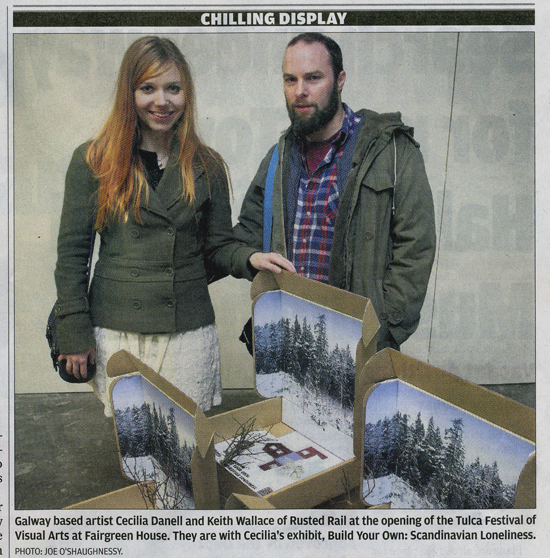
The Galway Advertiser, 15th November 2012.
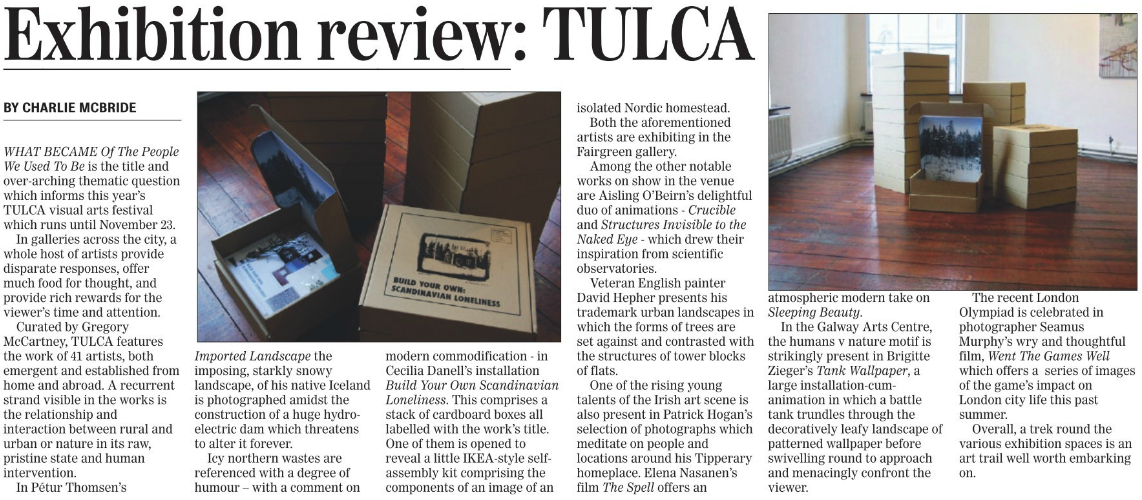
Irish Arts Review, Spring (March-May) issue, 2012.
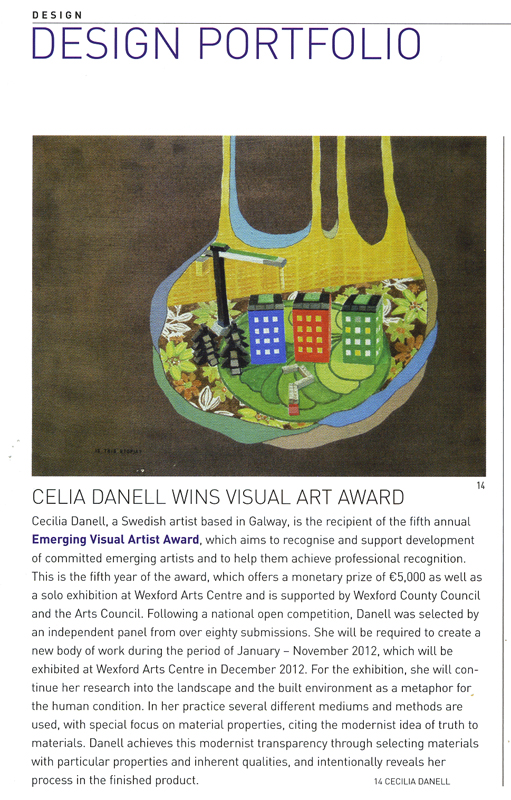
Review of “The Consoling Dream Necessity” by Sue Rainsford for Paper Visual Arts Journal, 09th April 2012.
CECILIA DANELL: THE CONSOLING DREAM NECESSITY, THE TALBOT GALLERY, DUBLIN, JANUARY 11TH – FEBRUARY 4TH, 2012
There is an emphasis on fabrication in Cecilia Danell’s The Consoling Dream Necessity, clearly demonstrated in the two installation pieces and paintings, where there is an insistence on our physical encounter with the landscape. Both this focus on ‘making’ and pathetic fallacy is evident in the project Build Your Own: Scandinavian Loneliness. Within a cardboard box are all the materials you need to construct your own segment of snow-clad wilderness. As well as referencing the physical landscape (that constitutes her Swedish heritage), it also comments on the impact of the landscape on the individual. Elaborated further in the paintings is this power our surroundings have over us in terms of mood. Despite an emphasis on the exterior, the paintings also refer to our inner-life, demonstrating a realisation that inner and outer can be made interchangeable; boundaries can be blurred up to the point of negation, so that we can’t tell if the images are abstract and skewed visuals or landscapes made strange by inward turbulence. With Build Your Own: Scandinavian Loneliness, situated as a pile of harmless seeming boxes in the middle of the gallery’s floor, there are unusual connotations; ‘build your own’ incites a notion of mass-produced and mass-possessed – if everyone has one, why shouldn’t you? And yet what we’re encouraged to construct is ‘loneliness’, and not only that but specifically Scandinavian Loneliness. With this direct tie to the artist’s biography and heritage we can’t ignore the outright personal dimension introduced, a facet that the paintings enhance and complement.
The paintings are imbued with a sparseness and a loneliness that is carried off by painterly technique as much as by the subject matter itself. What we are perhaps looking at is images of a secluded, distant Dystopia, somewhere we all recognise perhaps not for its landscape but for the associated feelings of estrangement and ostracism. The question raised is at what point do we all of us come to spend time in this setting? How deeply can we question ‘the self’ before coming up against this wall of ‘otherness’?
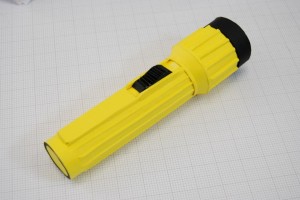 A small installation piece in the form of a yellow flash-light is mounted on a medium-height podium just inside the gallery’s entrance. A Tribute to Thomas Demand is a reproduction of one of the flash-lights that played such an important role in Demand’s 2001 piece, Poll, which replicated in paper the setting of the Florida recount in the 2000 election between George Bush and Al Gore. The recount depended largely on incompletely punched holes next to the candidates’s names on the ballot paper, and the flashlights were used to determine whether or not the votes could be counted. This reference to the material and tangible accents Danell’s work, illustrating the symbolic weight materials can undertake having at first played only a supporting role in a colossal endeavour. Danell’s tribute to Demand’s referencing the role of paper in a major historical event calls fresh attention to her own materials, and the nature of our interaction with these materials depending on their context. In Poll we see the initially banal connotations of paper inverted, as it becomes the deciding factor in a decision of global import. Danell’s flashlight and Build Your Own Scandinavian Wilderness employ the most normal and attainable of materials, but in the setting of a gallery they take on a purpose that far exceeds the utilitarian.
A small installation piece in the form of a yellow flash-light is mounted on a medium-height podium just inside the gallery’s entrance. A Tribute to Thomas Demand is a reproduction of one of the flash-lights that played such an important role in Demand’s 2001 piece, Poll, which replicated in paper the setting of the Florida recount in the 2000 election between George Bush and Al Gore. The recount depended largely on incompletely punched holes next to the candidates’s names on the ballot paper, and the flashlights were used to determine whether or not the votes could be counted. This reference to the material and tangible accents Danell’s work, illustrating the symbolic weight materials can undertake having at first played only a supporting role in a colossal endeavour. Danell’s tribute to Demand’s referencing the role of paper in a major historical event calls fresh attention to her own materials, and the nature of our interaction with these materials depending on their context. In Poll we see the initially banal connotations of paper inverted, as it becomes the deciding factor in a decision of global import. Danell’s flashlight and Build Your Own Scandinavian Wilderness employ the most normal and attainable of materials, but in the setting of a gallery they take on a purpose that far exceeds the utilitarian.
In the artist’s previous exhibitions, the mundane associations of such installation materials as graph paper, paper clips and twigs have been thrown into relief by the strangeness of the connotations they provoke. Similarly in The Consoling Dream Necessity, the strangeness of the landscape depicted is made stark by the familiarity it instills. Feelings of alienation and division are conjured by these images; what we see are the universal ramifications of what we assume to be insular and personal, so that paradoxically through feelings of estrangement a simultaneous sense of ‘connectedness’ emerges. Strange places seem familiar because something transcendental is invoked; we are cautious and conscious, always, of our own ephemerality and our emotional distance from others. This knowledge of an irreparable schism between the individual and the rest of the world is a persistent psychological theme, and Danell’s landscapes represent that space between our psyche and outside consciousness for the happenstance viewer as they perhaps represent for her a dissolving immediacy with her background and heritage.
Sue Rainsford is a writer based in Dublin.
Ireland’s Home Interiors & Living, Ireland February 2012 issue.
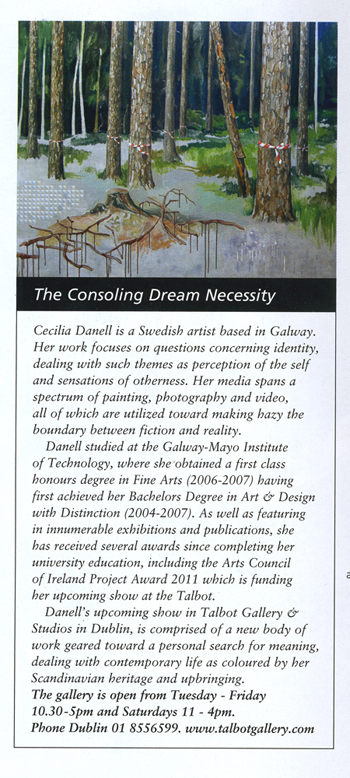
Degree show Critic’s choice – Review by Michaële Cutaya.
Circa 125 – Contemporary visual culture in Ireland. Autumn 2008 issue, page 62.
‘Is this Utopia?’ Cecilia Danell, Galway-Mayo Institute of Technology Degree show 2008.
